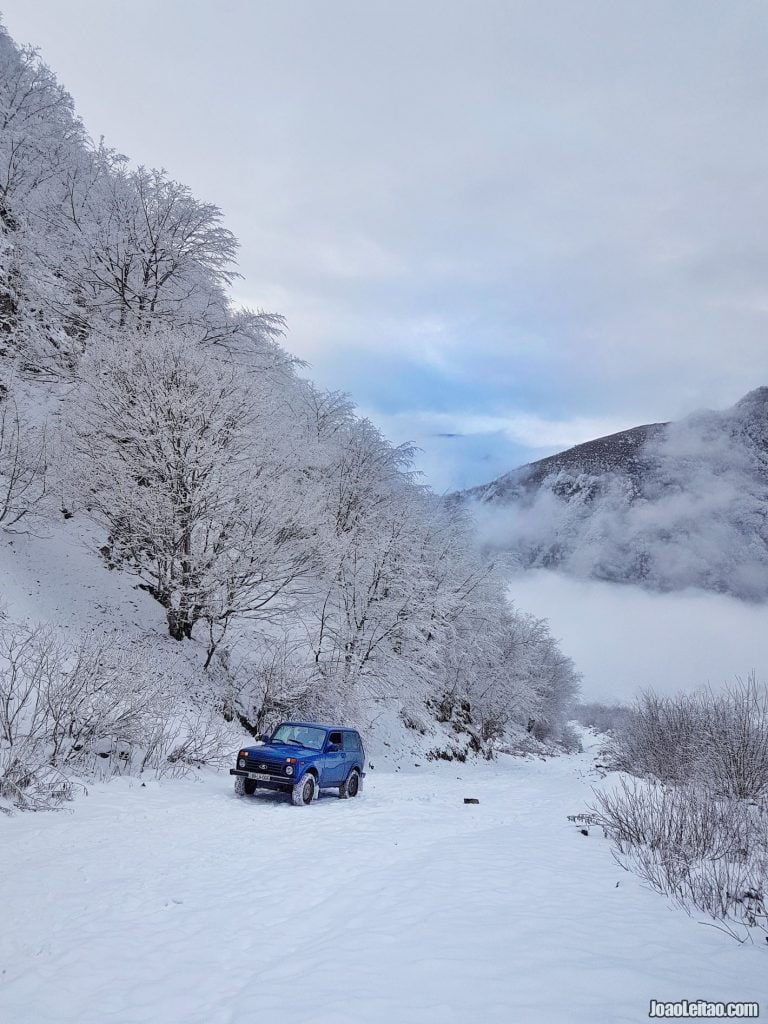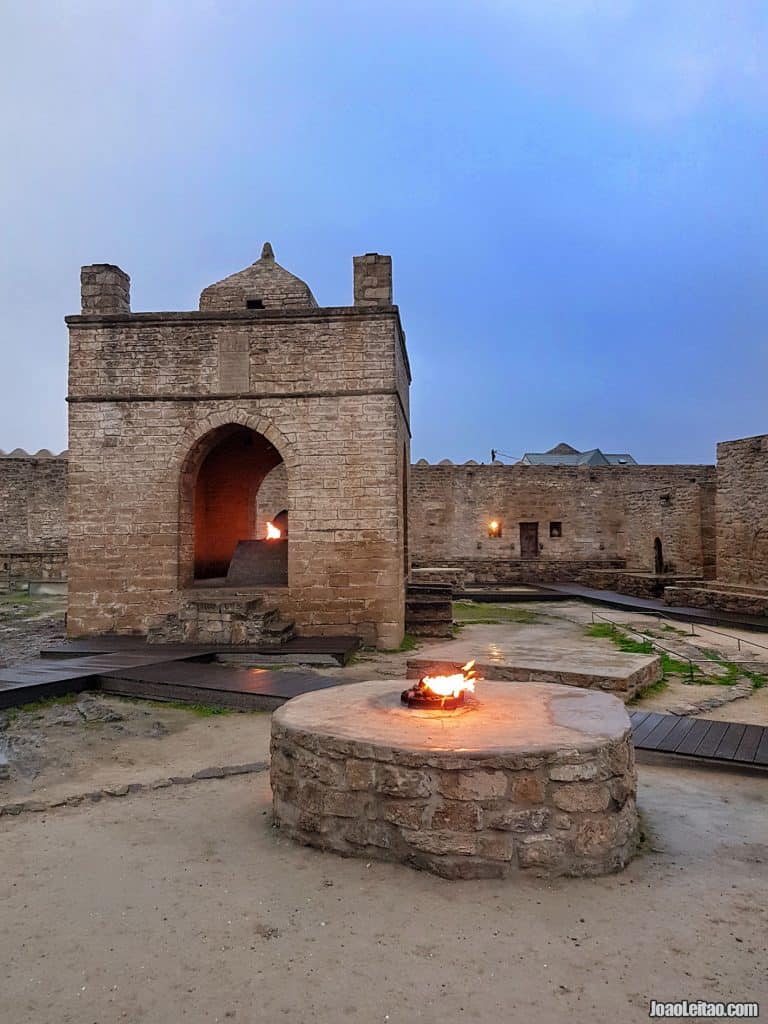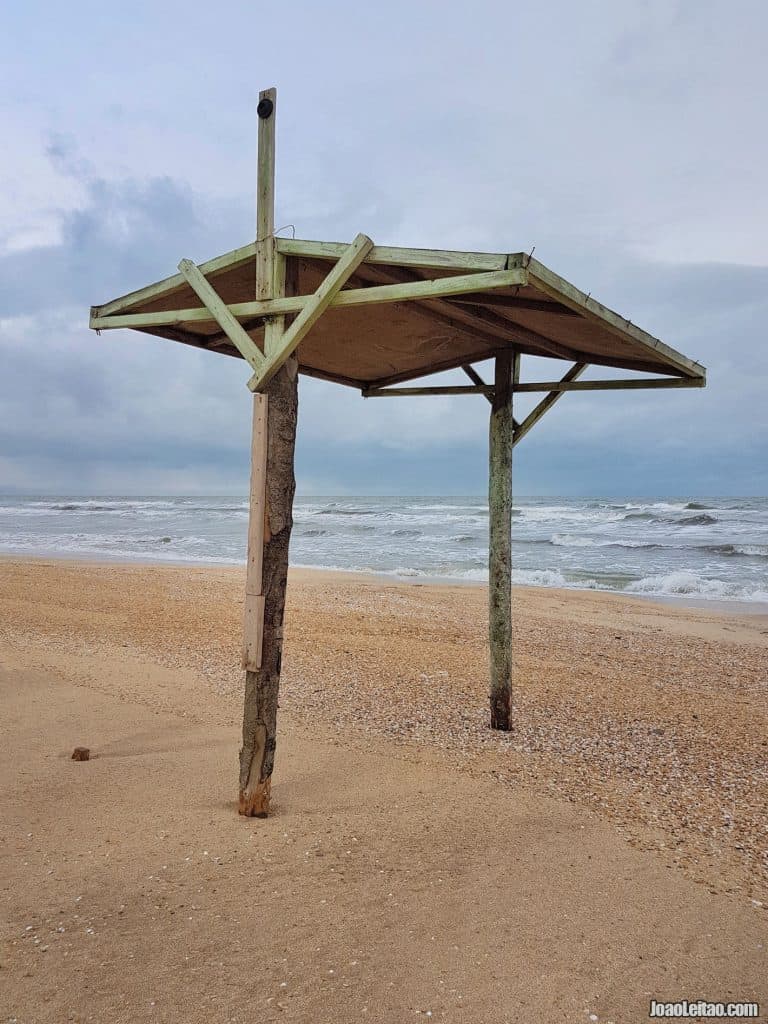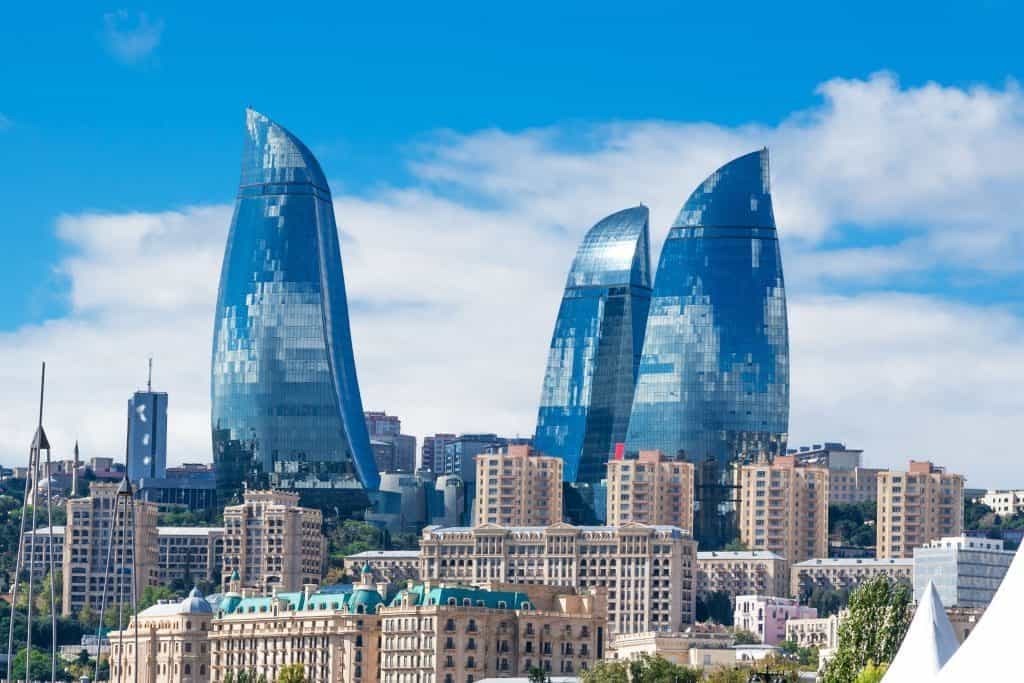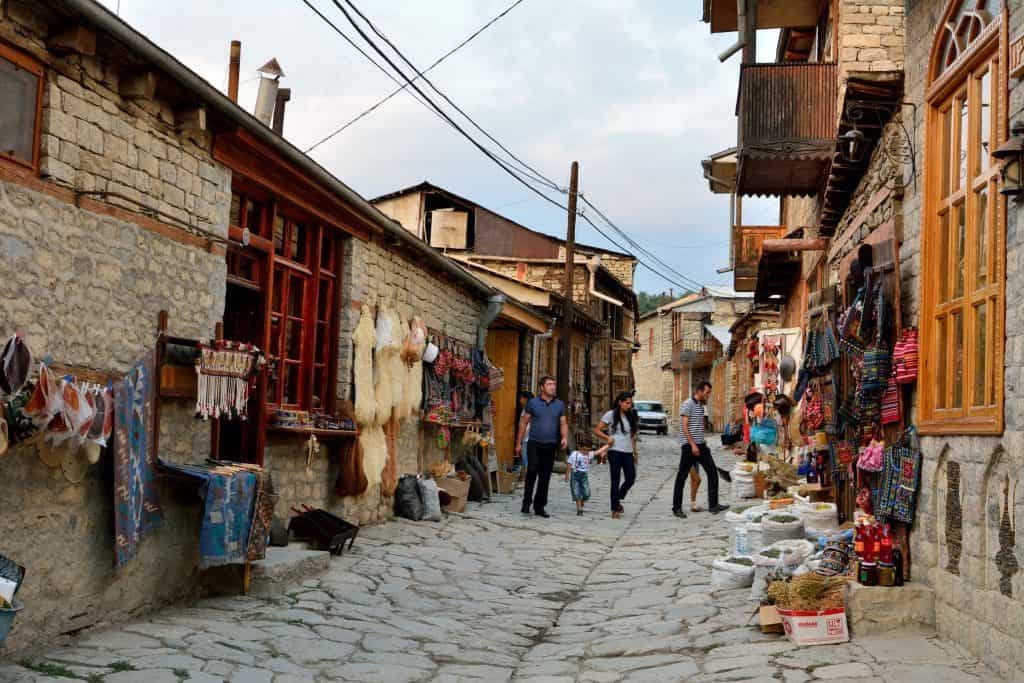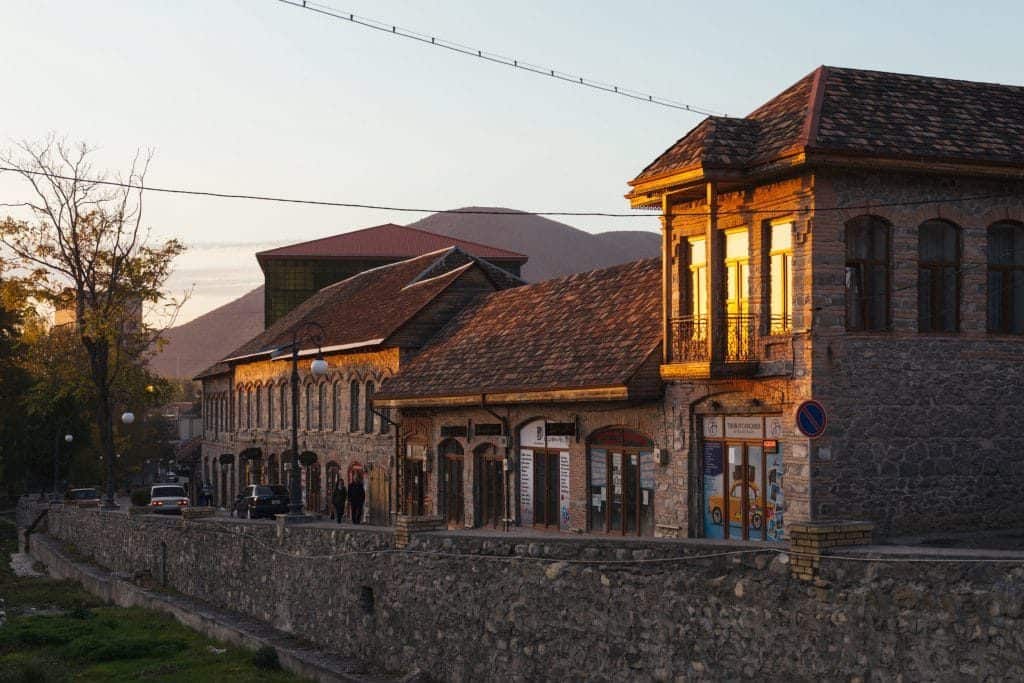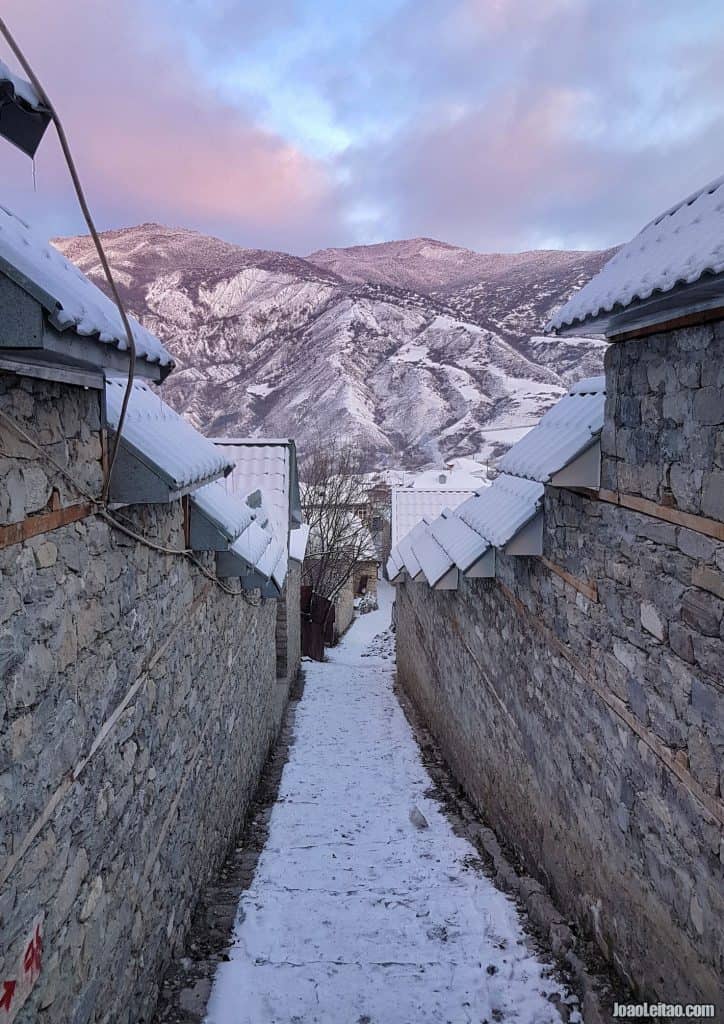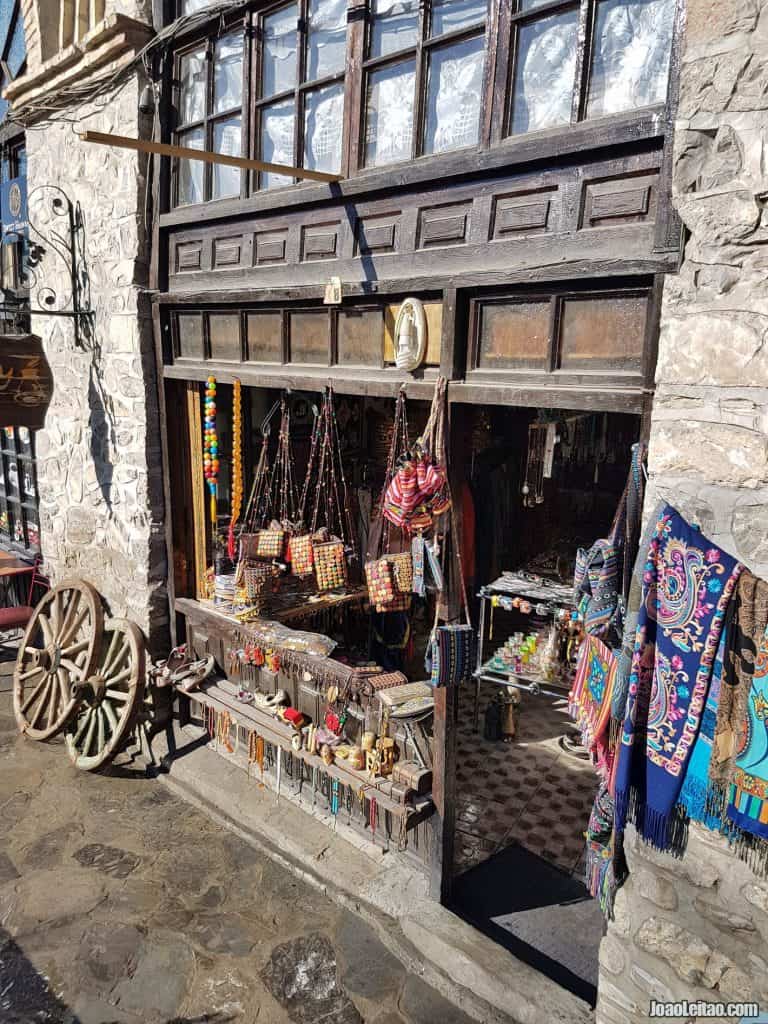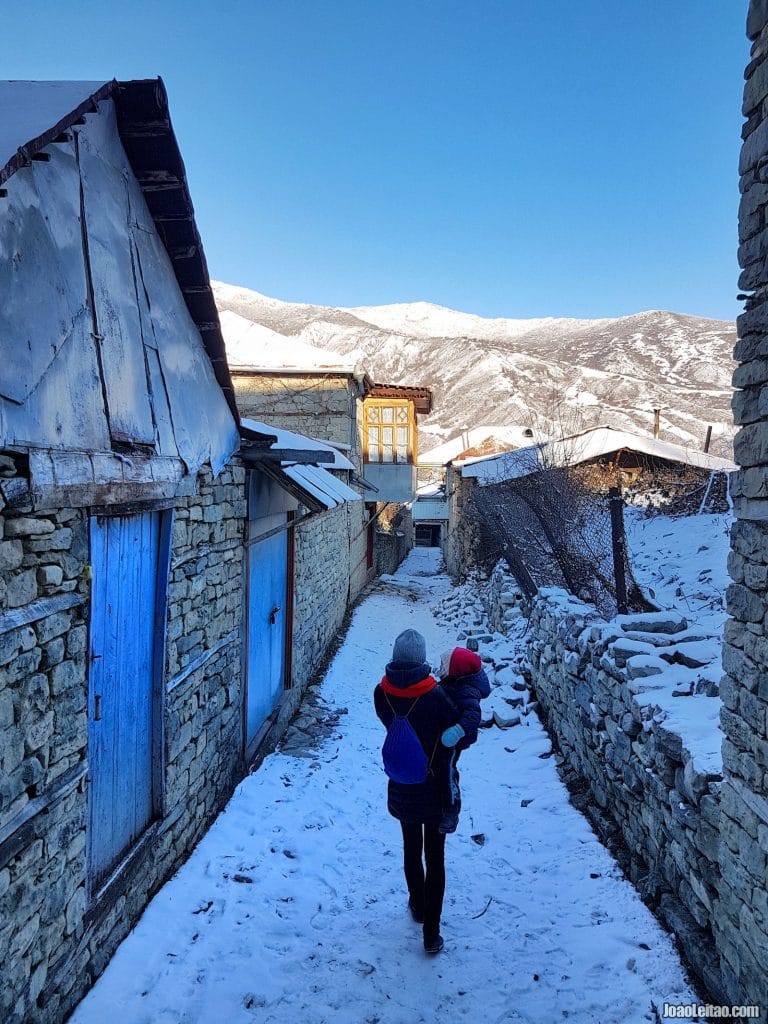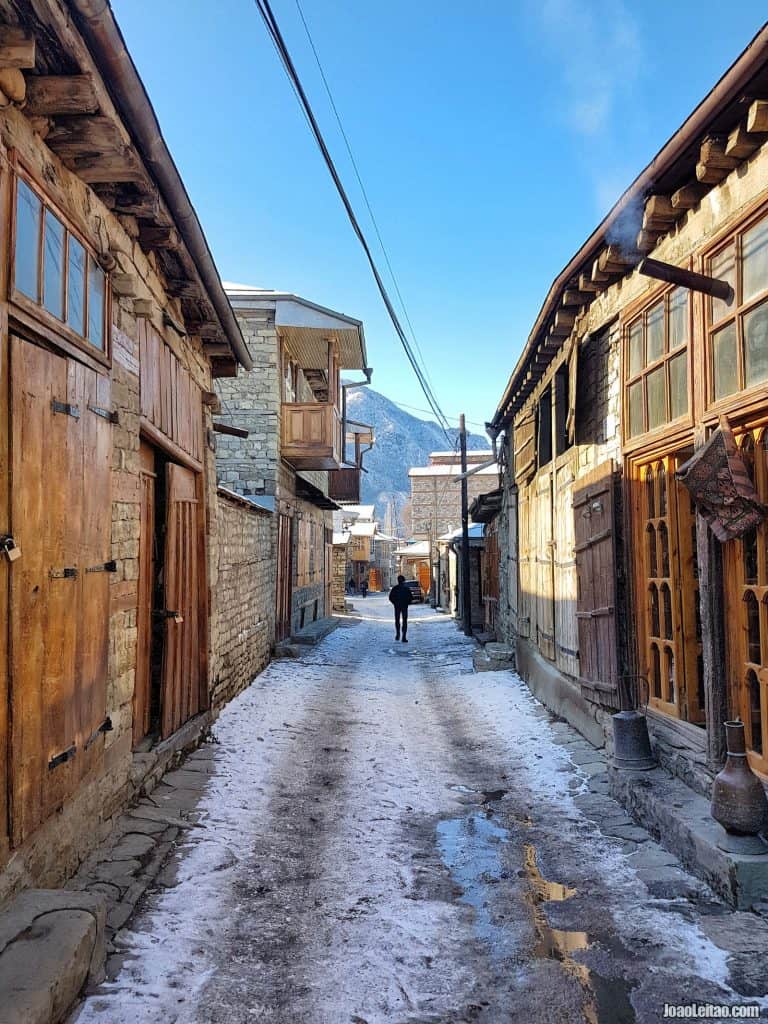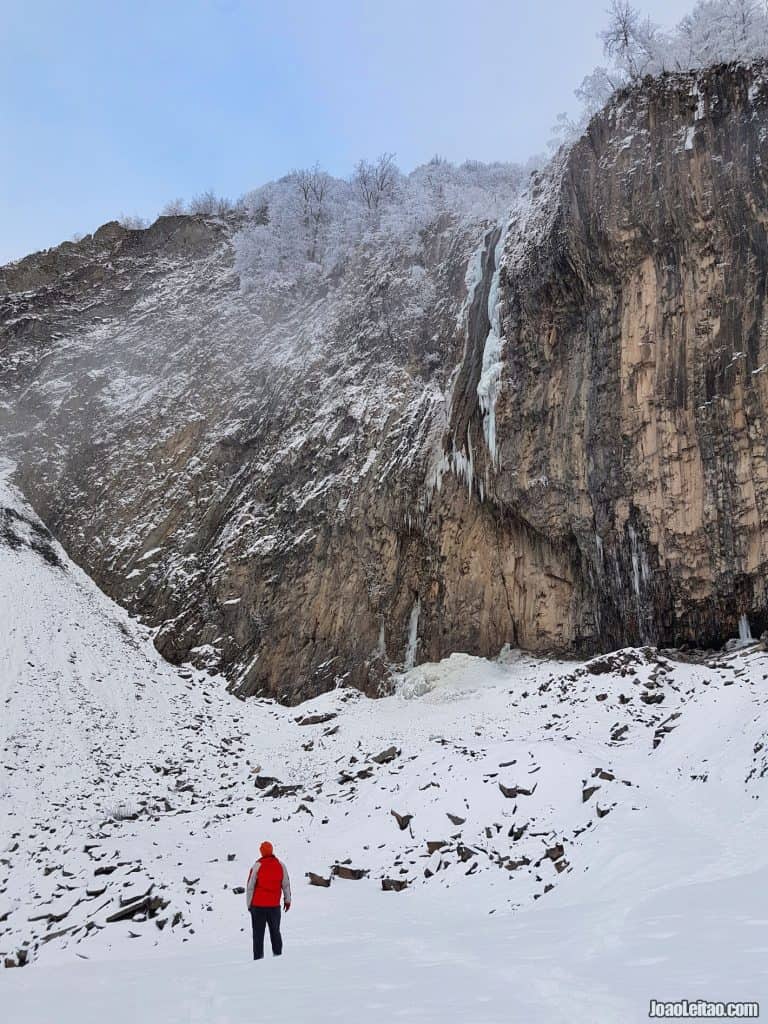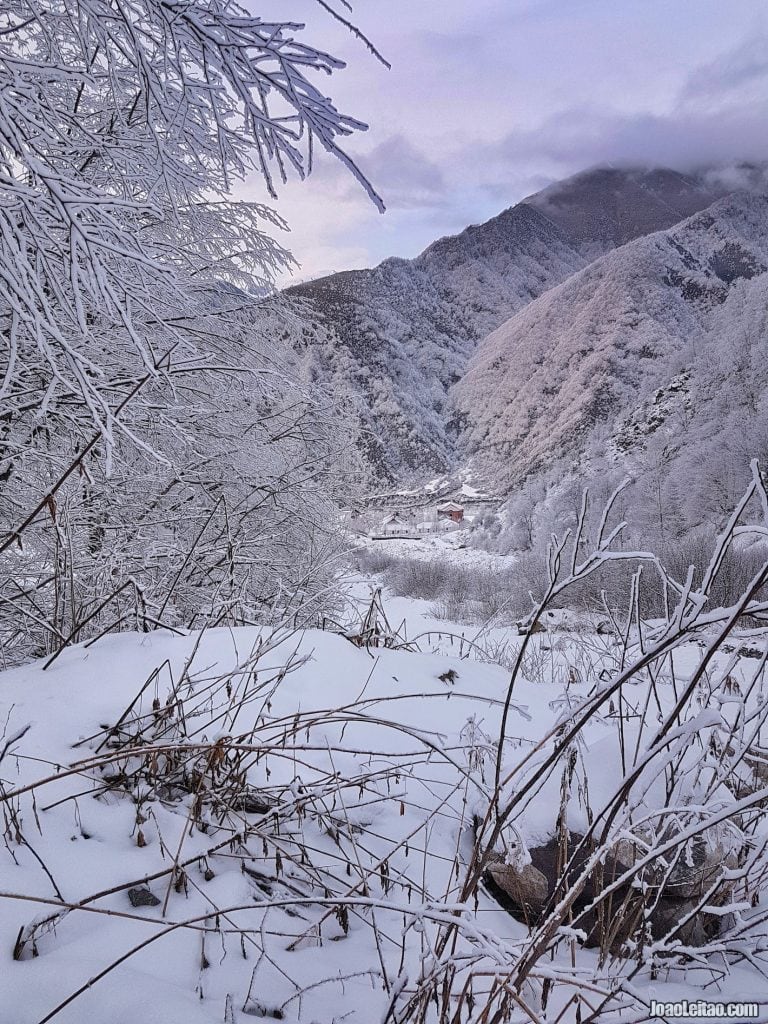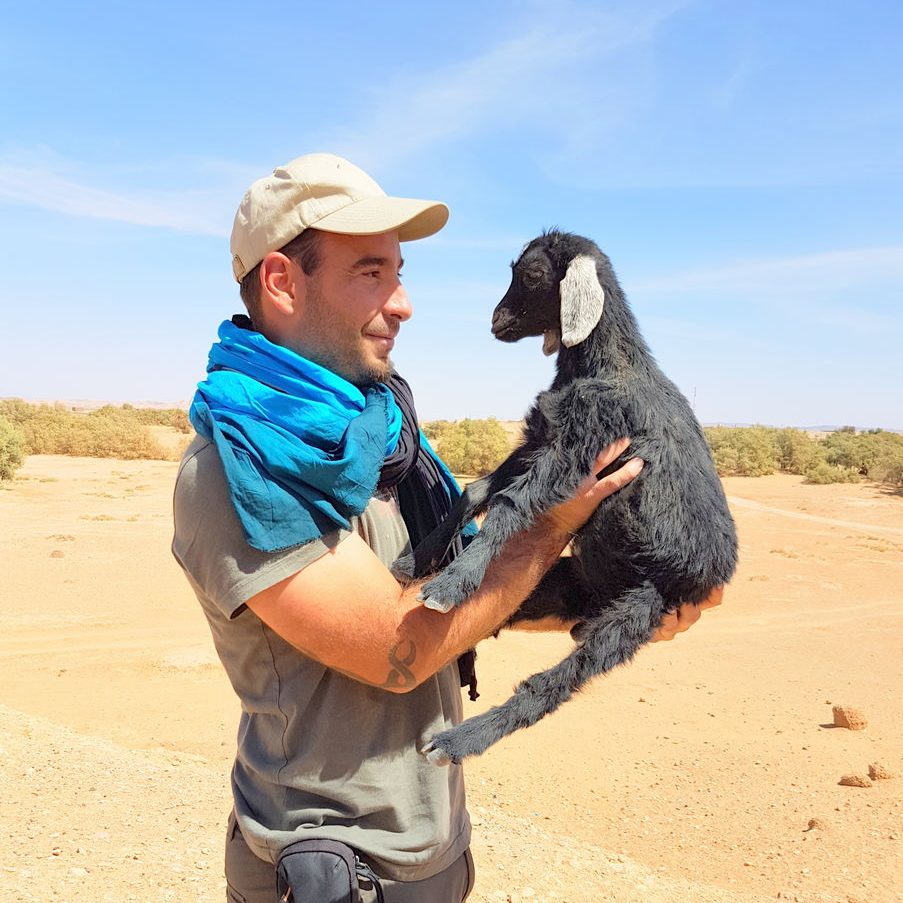Table of Contents
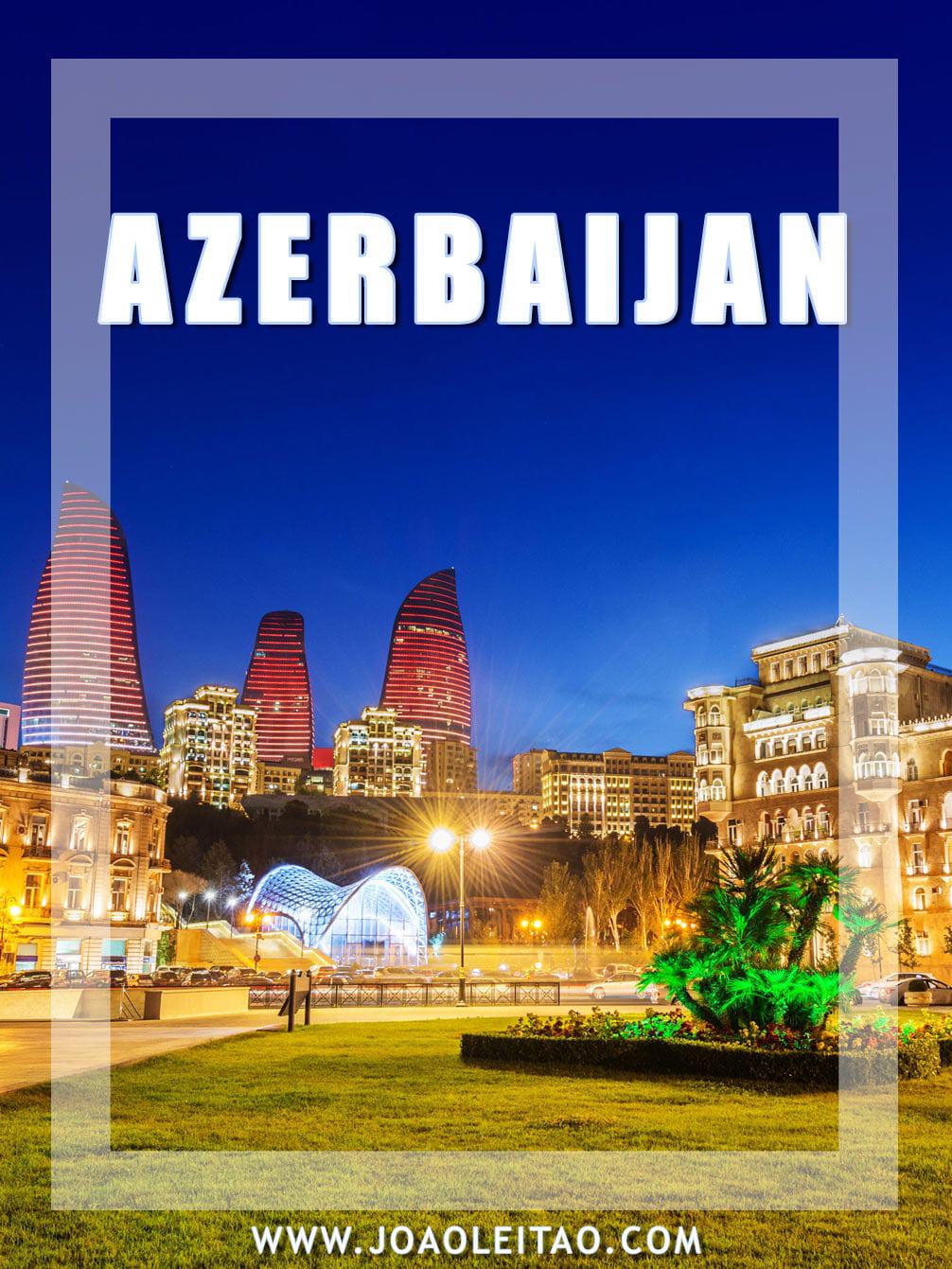
Azerbaijan was one of the 15 republics that were part of the Soviet Union and that became independent after the collapse of that massive country.
Welcome to my Azerbaijan travel guide specially made for your convenience and help you organize your next trip.
It’s one of the States of the Caucasus and has borders with Russia, Georgia, Armenia, and Iran, and it can easily be included in a larger itinerary that includes some of those neighboring countries.
As a travel destination, it’s heaven. The capital city, Baku, combines History with contemporary architecture and is especially appealing to those who enjoy urban spaces. Medieval castles and grand palaces are scattered all over the country. Those who grew up during the Cold War will particularly appreciate the traces of the Soviet era. All travelers are greeted with the Azerbaijani hospitality and their curiosity about people traveling from afar.
Nature is generous here, offering majestic mountains, lakes, beaches, and a diversity of animal species.
In Azerbaijan, different religions coexist in harmony. Most of the people are Muslim, but there are plenty of Christian churches from different periods and Zoroastrian temples. In fact, Azerbaijan is the oldest secular Muslim country, a status the country holds since 1918.
Azerbaijan Top 3
3
Baku
4
Sheki
5
Lahic
Best Time to Visit Azerbaijan
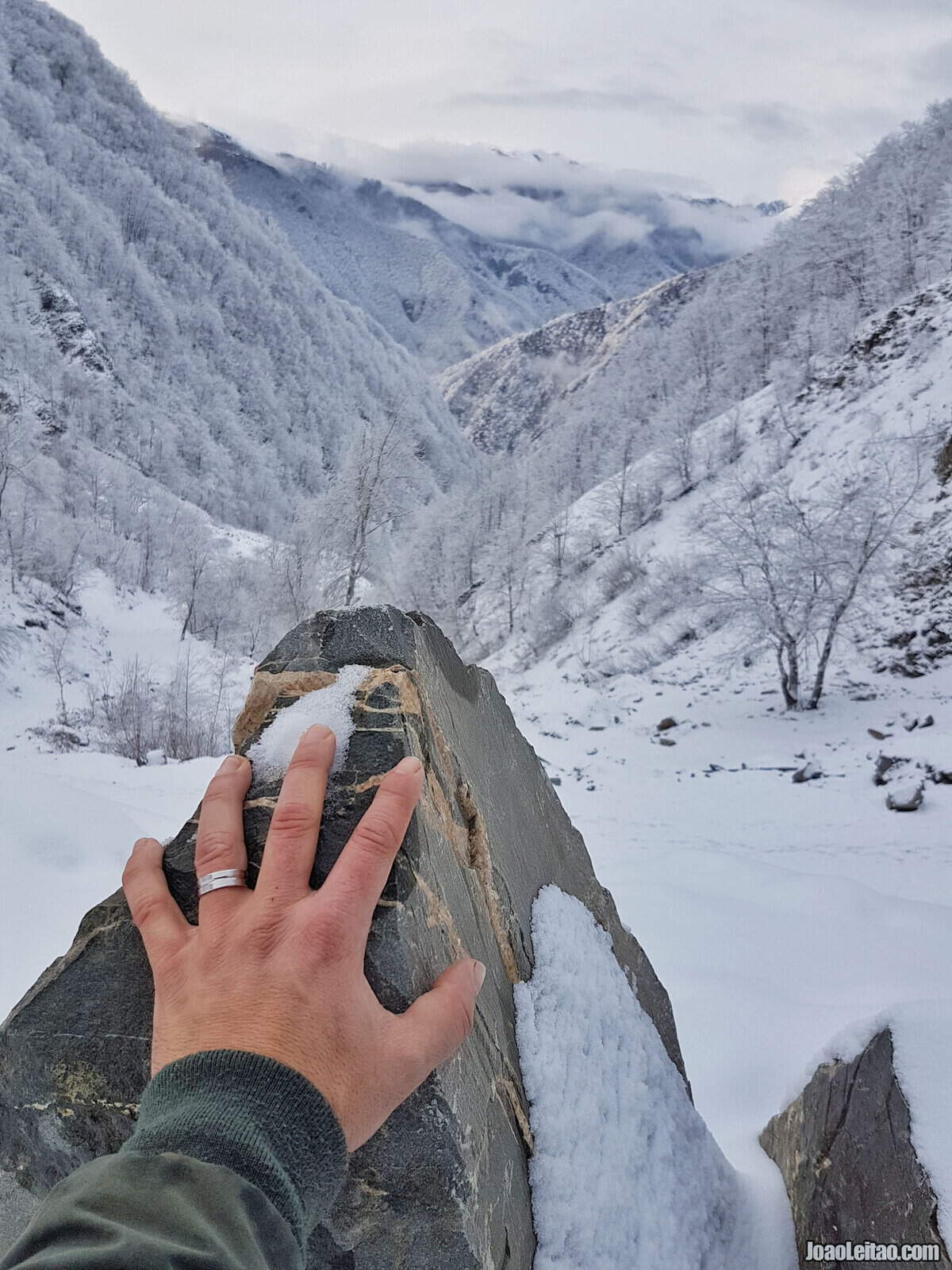
The right answer to this depends on what you want to do in the country. If you’re more interested in exploring the cities and getting to know the Azerbaijani culture, plan your trip for the months before the summer or the months after, which means April to June or September and October.
However, if the purpose of your trip is to hike the high lands, ideally you should travel in the summer when it’s really hot in the inhabited areas.
But each month has its pros and cons. Let’s see them one by one.
November to February
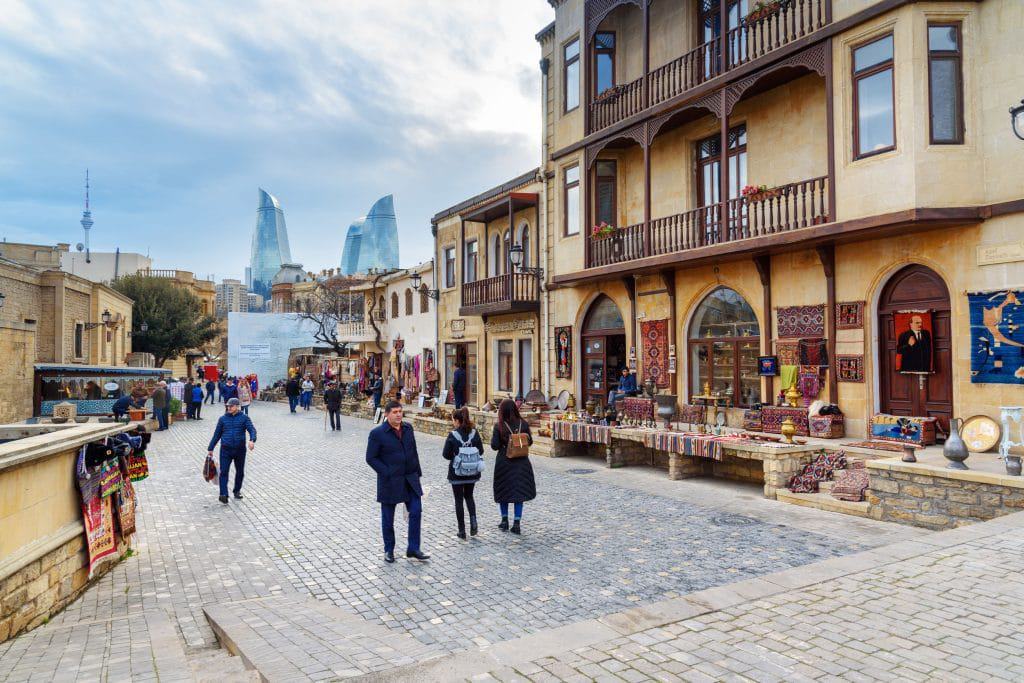
To be blunt, it’s cold. Not unbearably cold, though, because the mountains are like a screen protecting from the continental climate and the sea helps to keep temperatures mild. Expect Baku to be between 3 and 10 degrees Celsius, maybe a bit more in November. There are a few chances of rain but not in a way that it might ruin your trip. It probably rains for five days each month and eventually some snow too.
There are no trips to the mountain at this time of year. Extreme weather conditions sometimes mean the roads have to be blocked.
It’s still an interesting time to visit. Birdwatchers will be thrilled to know the natural parks in November become the home of a high number of migrating species. In December, although most of the population is Muslim, Christmas is celebrated with street markets and festivities that help bear the cold. New Year’s is celebrated too, especially in Baku.
Fewer travelers come here this time of year, which means accommodation is cheaper and tourist attractions are less crowded.
March and April
Weather shifts from March onward, with the first signs of spring. Snow starts to melt in the mountains and Nature welcomes new life. On the third week of the month, the country celebrates Novruz Bayrami, the Persian New Year, a celebration that was forbidden during the Soviet period.
However, March is still a cold month, even in Baku, where temperatures average between 4 and 10 degrees Celsius, and it rains for about five days.
It’s a good idea to travel here in time for Novruz Bayrami, for the celebrations and the traditional dishes, and then wait until spring is in full bloom to explore parts of the country that are usually too cold in the winter. The weather changes are notorious, with landscapes turning green and temperatures rising to 20 degrees Celsius in April, on good days.
May and June
This is the most popular time of year to visit Azerbaijan, and the weather shifts faster as time goes by. In May temperatures rarely rise above 22 degrees Celsius, but in June there are days when the temperature is 35 or 40 degrees Celsius. Rain is practically inexistent. There might be some rainfall for a couple of days in May, and then none the next month.
The Day of the Republic is celebrated on 28 May, the day when in 1918 after the First World War the short-lived Democratic Republic of Azerbaijan was founded. It was forcefully incorporated in the Soviet Union shortly after.
The best way to enjoy these weather shifts is to arrive by mid-May, visit the capital and other cities in the plains. Then, when the weather starts to warm up, and the summer begins, spend a few days at the beach and head over to the mountains for cooler temperatures and the beautiful landscapes of the Caucasus.
July and August
Summer months are slightly uncomfortable in most of the Azerbaijani cities. Intense heat leads locals to trade Baku for vacation time near the coast, especially at the beaches near the Absheron Peninsula.
If you plan to travel here at that time of year, you can try visiting Baku. If you can’t handle the high temperatures, after all, go to Lake Goygol, Quba, or even follow the lead of the Azerbaijani and travel to the beach resorts.
September and October
This is one of the recommended times to visit the country because weather-wise it’s balanced. On average, it rains for six days each month. The mild temperatures and low rainfall are perfect for hiking and other outdoor activities, and to explore the cities in Azerbaijan.
It’s also peak season for tourism, so you should book accommodation in advance and expect to pay a little more than in the shoulder and low seasons.
Please note that fall arrives abruptly. Weather becomes unpleasant, and it could drizzle for days. If possible, avoid traveling in the last weeks of October.
Visas to Azerbaijan
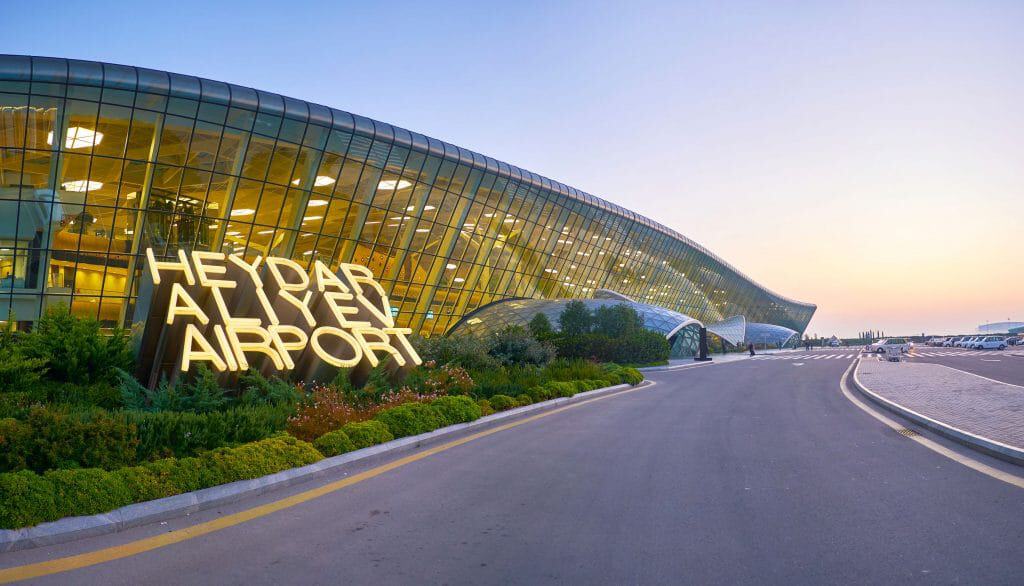
Azerbaijan began granting visas online in January 2017, what local government calls ASAN.
These visas are valid for 30 days, for one single entry in the country, and the citizens of 95 countries can apply for one.
They’re issued within three workdays, sometimes less than that. After you receive your visa in your email, you must print it and show it when entering the country with your passport. The passport must be valid for more than three months counting from the end of the 30 days of the visa.
The e-visa costs USD 23, urgent requests cost USD 50, and the visas are issued within three hours.
Applying for an e-visa is simple. Choose the date you think you’ll enter the country. The visa will be issued for 90 days counting from that date. However, this doesn’t mean you can stay in the country for 90 days. It means you can postpone your trip and still use the same e-visa. You can’t stay in the country for more than 15 days and must always leave before the end of the expiry date on your visa.
When applying for a visa, your passport must be valid for more than six months, and you must send a scanned copy of your passport’s front page. You must also provide an address for where you’re staying in Azerbaijan, at least during the first few nights.
The citizens of a large part of former Soviet Union countries don’t need a visa to enter Azerbaijan and citizens of some other countries can request visa on arrival at international airports.
How to get to Azerbaijan

Flying into Azerbaijan is doable, but not simple. Turkish Airlines and Lufthansa operate flights to Azerbaijan, with layovers, that usually cost more than 400 Euros and take 10 hours each way.
However, you can choose from the many low-cost airlines carriers like Wizzair and fly to Budapest and from the Hungarian capital to Baku for 200 or 300 Euros. Those prices are for trips in the spring.
Many people include Azerbaijan as part of an extended trip that includes Georgia and Armenia, and that opens up a different range of possibilities. Wizzair flies to Kutaisi, in Georgia, from more than 20 airports, including some with good connections such as London Luton, Barcelona, Paris, or Warsaw.
Once you are in Georgia, you can depart from Tbilisi on the night train that leaves every day at 8:35 pm and arrives in Baku the next day at 9 in the morning.
A ticket for a private car in first class costs 28 Euros per person, a value option if you’re traveling with someone. For a car with four beds in second class, you’ll pay 15 Euros for a ticket.
I arrived to Azerbaijan crossing the Caspian Sea, coming from Kazakhstan on my 1-year van life trip across Central Asia and the Middle East.
Public Transportation
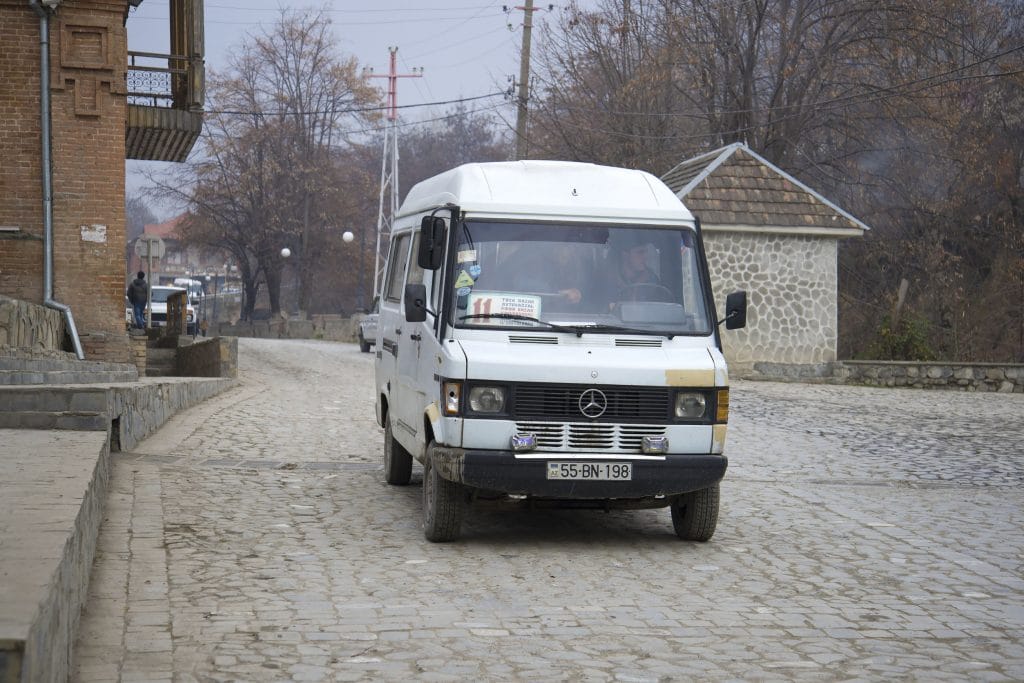
Traveling in Azerbaijan is easy, especially between cities. There are countless buses, shared taxis, and Marshrutka vans (a common name for this mean of transportation used by all the former Soviet Union countries).
You can also travel by train between cities, which could come in handy for night travels and for saving money and time, instead of staying overnight at a hotel. You can check the schedules and buy your tickets online at the official website of the Azerbaijan railway company https://ticket.ady.az/en
To get around in the city, taxis are the cheapest option and an excellent way to travel to remote places in the outskirts. Remember to always negotiate the fare.
How to Get a SIM Card in Azerbaijan
If you fly into Azerbaijan, try buying a SIM card at the airport. It will probably be a bit more expensive than in the city, but it will be simpler and faster.
If you buy the card in the city, it might take longer. You have to wait your turn, fill a pile of forms, pay at the cashier, fill more forms again. In Baku, I recommend the Azercell store at Fountains Square. You’ll need to take a number and wait your turn, and have your passport with you.
As for how much it will cost, it’s best to see what kind of deals are available at the time. But to give you just an idea, at the airport a card with 10 GB of data and 20 minutes of international calls (local calls are incredibly cheap) will cost you about 25 AZN.
If you buy it in the city, you’ll probably pay less than 20 AZN for more or less the same card. It’s very affordable, and network quality and speed are quite good.
A 15-Day Itinerary to Visit Azerbaijan
Baku (2 days + 1 to visit Gobustan)
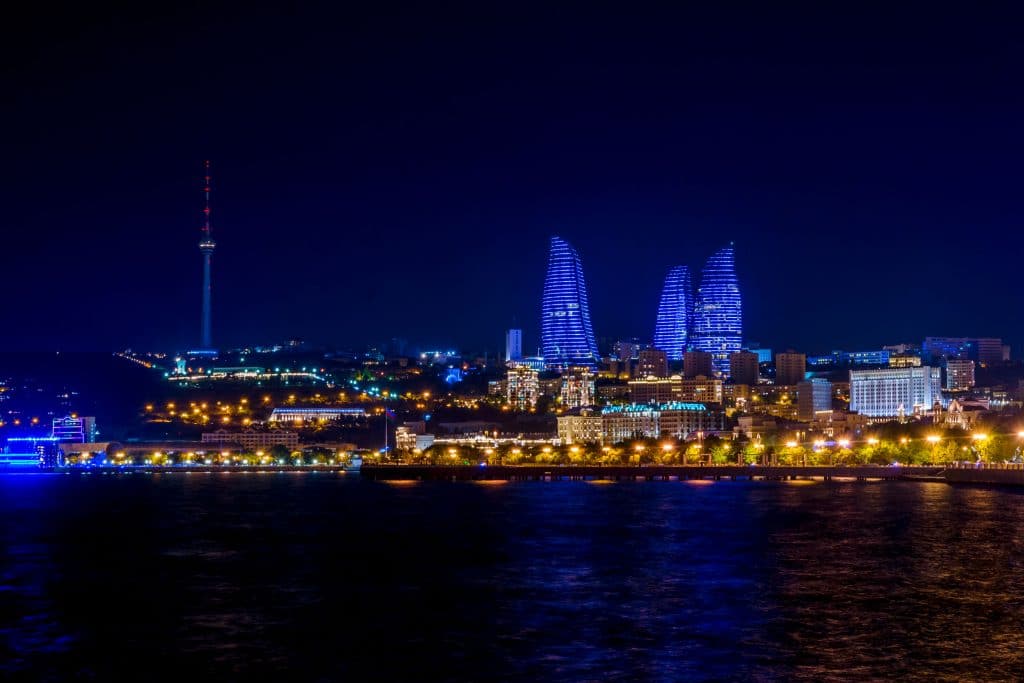
Baku is the capital of Azerbaijan and the main gateway into the country, not only for those who travel by plane but also for those who arrive by train from Georgia or Turkey.
Arriving by Plane
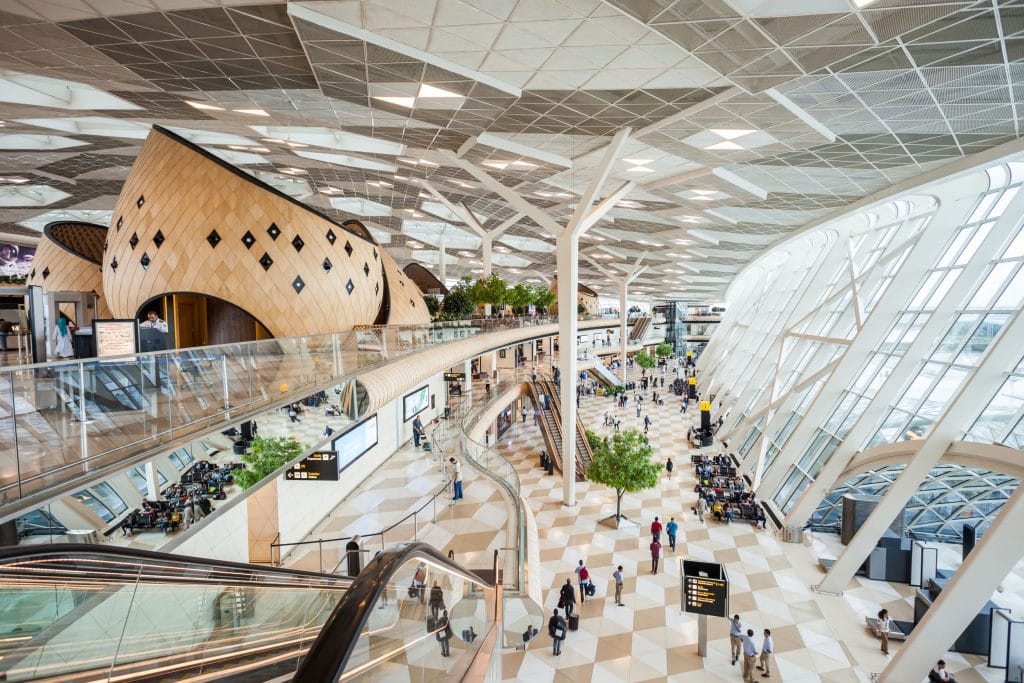
If you’re landing at the modern and lovely Heydar Aliyev International Airport, you can take one of the local taxis to the city center, which is 25 km away. If you do, negotiate the fare.
Although taxis are metered, it’s unlikely that you’ll leave the airport without negotiating a fixed rate for the service. Taxi drivers will start by asking 50 AZN when the fair price is about 15 AZN. However, if you manage to lower it to 20 AZN, it’s not too bad. The return trip to the airport is usually cheaper, sometimes under 15 AZN.
If you manage to dodge the crowd of taxi drivers looking for customers, you can take the bus, but you need to buy a Baku Card. The card costs 2 AZN and the trip from the airport to the city is about 1.5 AZN.
Arriving by Train
The central train station in Baku is in the center of the city and is served by the subway station 28 May.
Things to See and Do in Baku
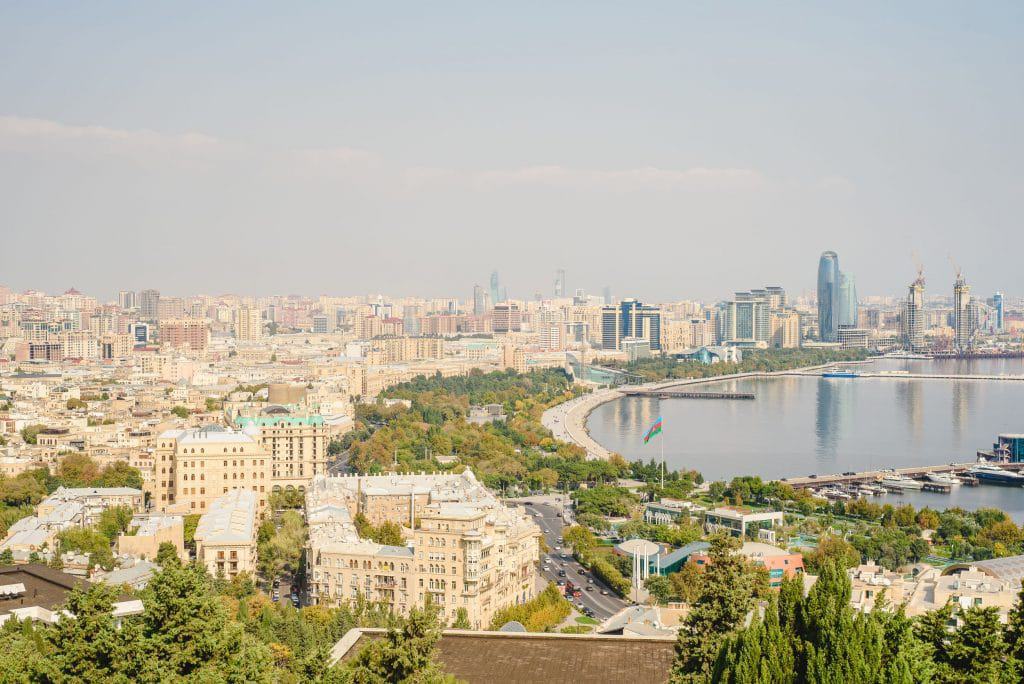
Old City
Baku was an obscure small town until oil was found in the region. It became the base of all industries in the country, and offices of the companies trading in oil settled in the city. The Old City is practically the only part of Baku before that time of urban growth.
Don’t skip the Palace of the Shirvanshahs and the Maiden Tower.
Baku’s historic center is one of the two UNESCO World Heritage Sites in the country.
Flame Towers
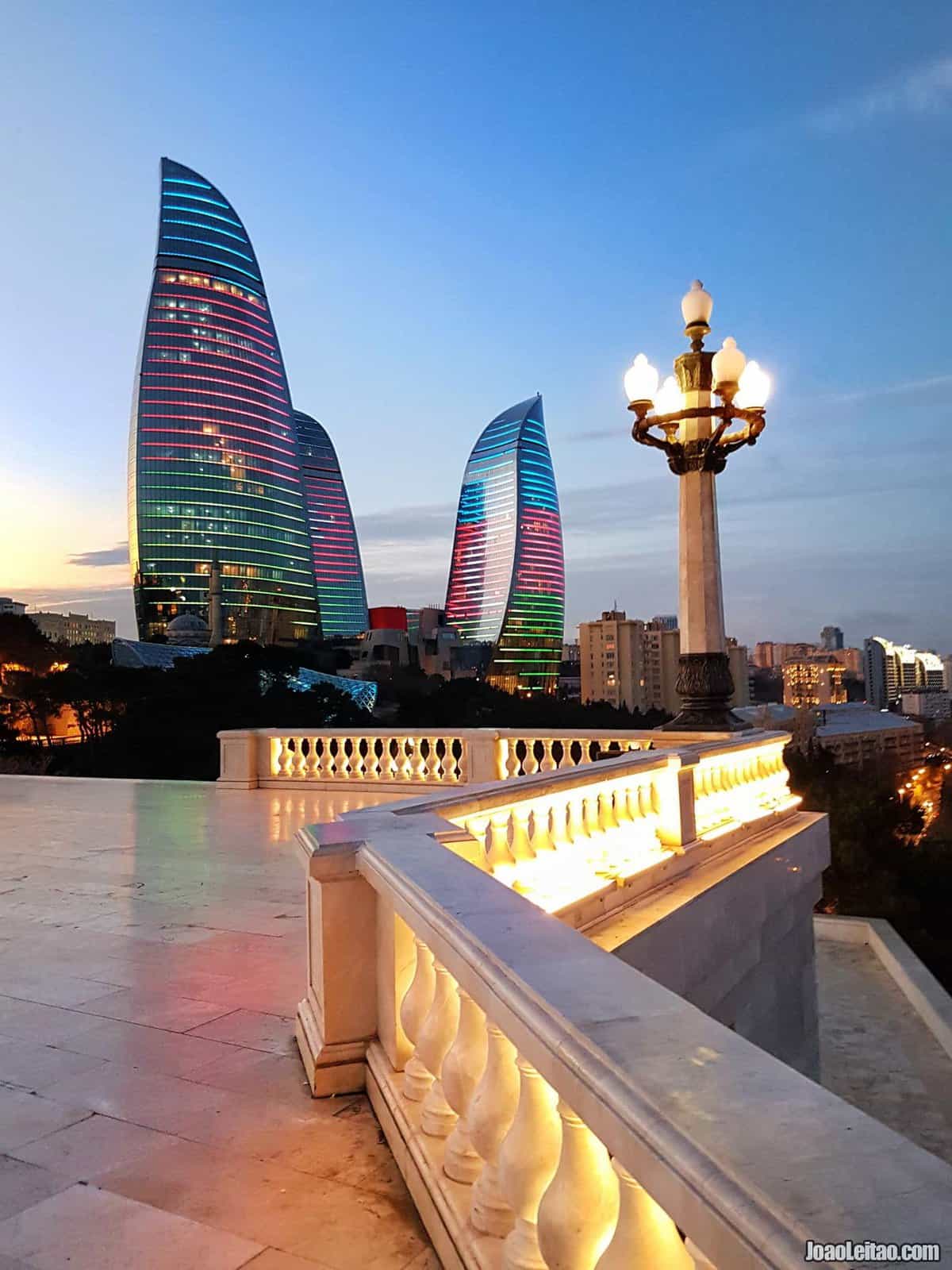
The Flame Towers are the most modern buildings in the Caucasus, built between 2007 and 2013. The highest of the three towers is 182 meters tall, and the other two are 160 meters tall. They’re an iconic symbol of the city, and they look better when seen from a distance, especially at night when they light up.
Caspian Sea Promenade
The Caspian Sea promenade stretches along 3 km. It’s a clean, modern, and orderly area with vast greenery and a lovely view of the Caspian Sea. It’s also known as Baku Boulevard and connects the two main historical squares in the city, National Flag Square, where a huge flag is hoisted, and Freedom Square, formerly known as Lenin Square and where the Government headquarters are.
Heydar Aliyev Center
This modern cultural center is one of Baku’s main attractions. The prestigious English-Iraqi architect Zaha Hadid designed this building of curvy, bold lines, worth the visit just to take photos of the outside.
The design is inspired by the handwritten signature of Heydar Aliyev, the first president of independent Azerbaijan and whom the center is named after.
To get inside and visit the exhibitions, attend a show, or go to a conference, look for the entrance on the west corner.
Buses 11 and 24 stop near the Center.
Azerbaijan Carpet Museum
Albeit smaller, the Carpet Museum’s style is as bold as the Heydar Aliyev Center, designed as a replica of a carpet being unfolded.
Inside you’ll see an exhibition with the most beautiful carpets produced in Azerbaijan. In a country where tapestry is considered the national art, be ready for a treat.
You can buy a carpet at the museum shop but don’t forget to keep the certificate. Without it, you won’t be able to take the carpet out of the country. If the carpet is over 30 years old, you’ll need to pay an extra fee and get permission from the Ministry of Culture.
Maiden Tower
No one knows when this bizarre tower was built, but it was probably between the 7th and the 12th century. It might have been a lighthouse, an observatory for astronomers, a Zoroastrian temple, or simply used for military defense.
Inside there’s a museum dedicated to the history of the structure, showcasing the history and the myths around it.
It’s open every day from 10:00 am to 7:00 pm and foreigners pay 10 AZN for a ticket.
Palace of the Shirvanshahs
This grand palace was the political center of Azerbaijan for a large part of the Middle Ages. Most of the building dates from the 15th century, but it was restored in 2003 with dubious methods. Together with the Maiden Tower and others, it’s classified as a UNESCO World Heritage Site.
Fountains Square
It’s Baku’s functional center and one of the locals’ favorite spots, also known as Parapet. The origin of the current name are the multiple fountains placed there during the Soviet period.
Around the square, you’ll find some of the best stores in the city, and the commercial energy at the square is constant.
This square is also where the city government hosts events, festivals, and concerts.
National Museum of History of Azerbaijan
The Museum of History is in the center of the city, not too far from Fountains Square. It has an exhibition dedicated to the history and the culture of Azerbaijan, and it’s the largest museum of its kind in the country.
In addition to the over 2,000 pieces on display, the interior of the building is also worthy of attention. It’s a Renaissance-inspired construction, built at the end of the 19th century and beginning of 20th century by one of the first oil tycoons, HZ Tağiyev.
The building was immediately confiscated when Azerbaijan became part of the Soviet Union and turned into a museum in 1920, that would later become the modern Museum of History.
Tahir Salov House Museum
Tahir Salov is perhaps the most prestigious contemporary painter of Azerbaijan. You can visit the exhibition put together at the house he once lived, in the historic center of Baku.
In addition to the paintings of Tahir Salov, the exhibition includes a collection of photos and decorative pieces.
It’s open from Monday to Friday from 9:00 am to 9:00 pm and the ticket costs 2 AZN.
Day trip from Baku: Gobustan National Park
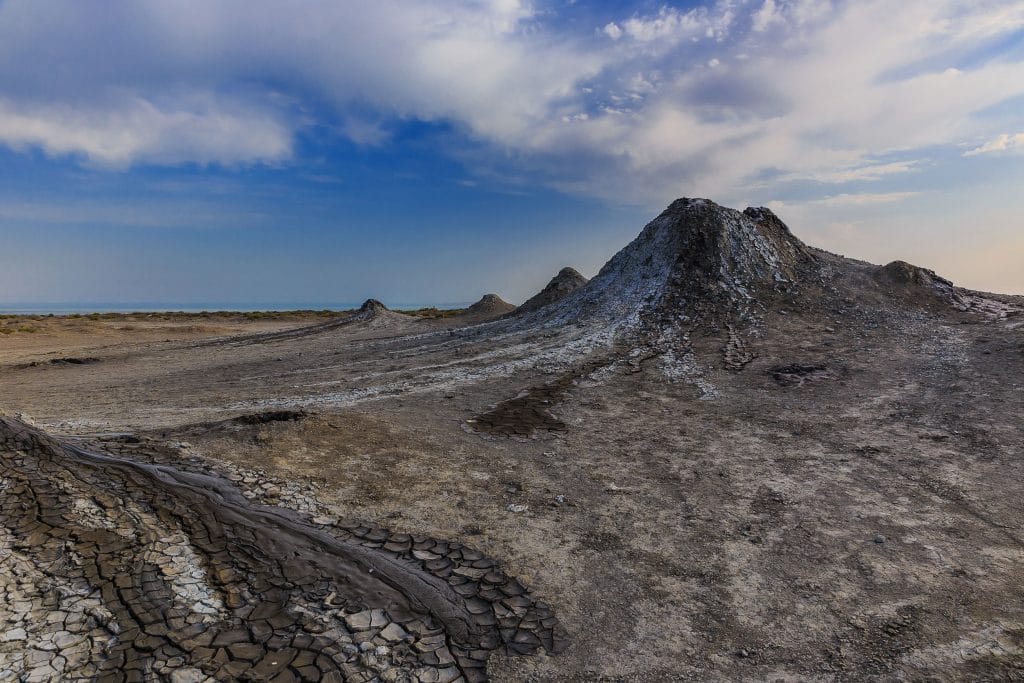
The Gobustan National Park is the second place in Azerbaijan that’s been a UNESCO World Heritage Site since 2007 and that you can visit on a day trip from Baku.
It’s about 50 km south of the capital, and you can go on an organized tour that costs about USD 70 per person. If you think it’s too expensive, you can take public transportation instead. Take bus 195 at bus terminal 20th January to Alat and get off at Gobustan. The entrance to the park is about 3 km, so you can walk there or take a taxi.
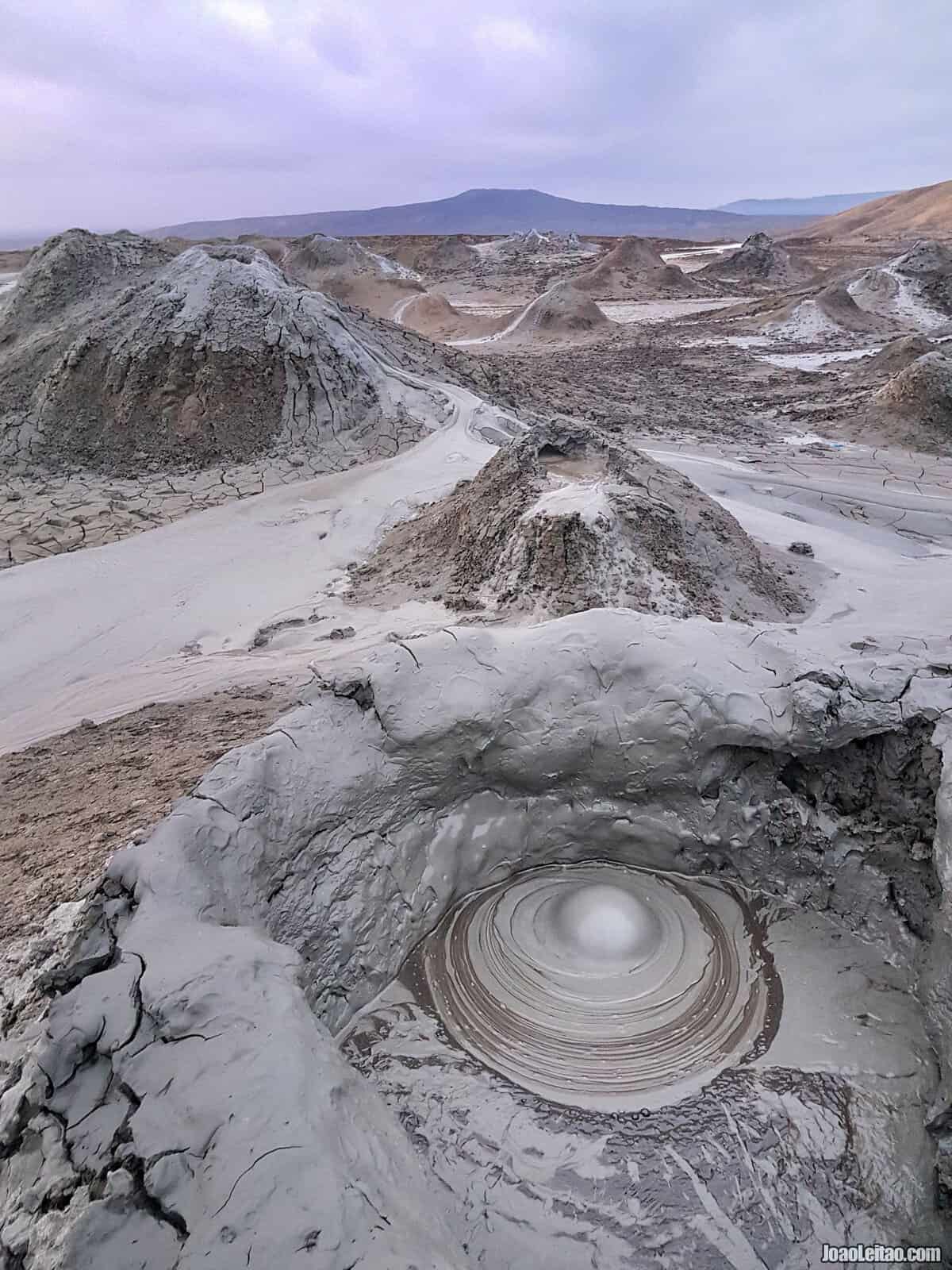
Two particularly interesting things are must-sees at the Park: the petroglyphs and the mud volcanoes. There are over 600 rock engravings created between 12,000 and 15,000 years ago, to which the armies of Trajan and Alexander the Great added their own inscriptions.
At the park, you can visit the modern interpretative center museum and see the petroglyphs, but you need to get a taxi to get to the mud volcanoes.
Lahic (2 Days)
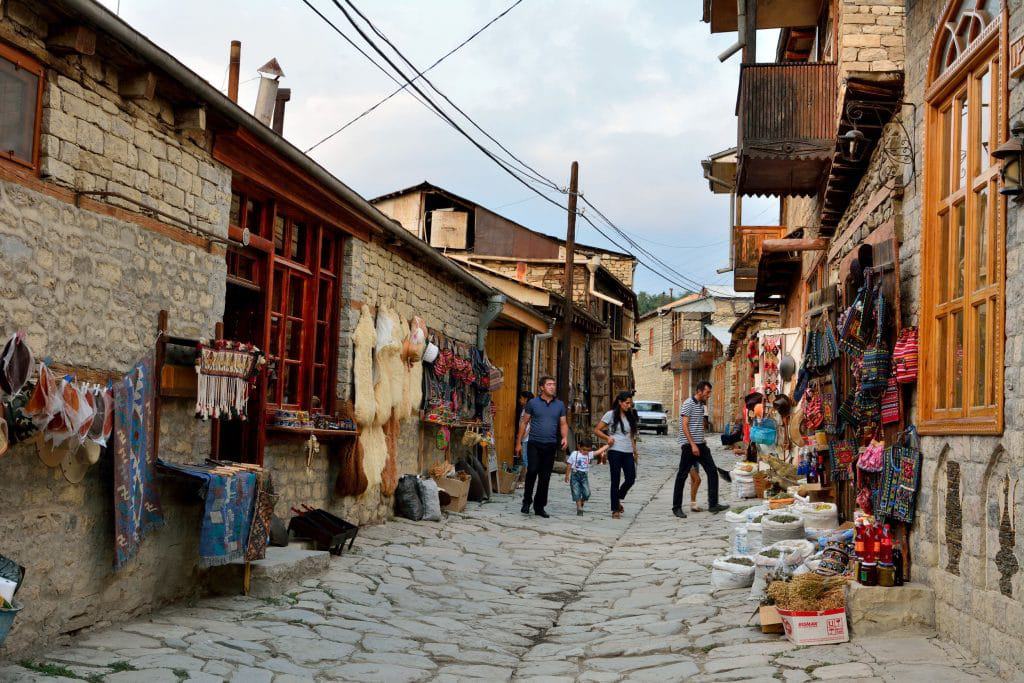
Lahic has the expected atmosphere of and is organized as a mountain town. It stands out for the Persian origin dialect spoken there and its blacksmiths that still work using traditional methods.
The best time to visit is on weekdays when locals are more authentic and open to interact with you considering that local tourists flock to the village on weekends.
At the time of the Silk Road, Lahic’s products were highly praised and were frequently sold in bazaars in Bagdad or Damascus. Surrounded by rugged mountains, the land in the village is not great for agriculture, which stimulated the growth of other industries. Lahic’s carpets and copper work have been famous for centuries.
Lahic is an excellent place to stay for a couple of days, exploring the streets and hiking, with endless possibilities for outdoor activities.
Getting There
There are direct buses from Baku to Lahic, but tickets sell out fast with so many locals traveling there for the weekend.
If you run into this problem, take a bus to Ismaili and from there take a shared taxi or a marshrutka for the rest of the way. Expect a four-hour trip from Baku to Lahic, at best, but it will probably take four or five hours, maybe more depending on what kind of transportation you get in Ismaili.
The scenic trip, especially the last part, takes you to a very different Azerbaijan from the one you left in Baku. It’s mostly rural landscapes, forests, wild horses that run as soon as they hear a car coming, small waterfalls, and distant mountains.
To spend the night, find one of the many short-term rentals available in Lahic (unless they find you first). It will cost between 10 and 15 AZN, with breakfast included.
What to See and Do in Lahic
Hüseynov küç
Walking through the main street in Lahic is like traveling back in time. With an irregular, imperfect pavement, it’s lined with traditional houses made of stone and wood, some of them with beautiful balconies made of wood as well.
Although many of the traditional establishments in Hüseynov küç were replaced with modern shops, there are still some gems waiting to be found like the blacksmiths’ workshops.
Museum of Local History
This museum was founded in 1985 and is currently managed by Aliyev Maarif Aghamehedi. The collection with 1,000 pieces is on display in one single room. It includes many photos, tools used to work the copper, and pictures of notable people in the village.
The museum is free entrance and is housed in an old mosque built in 1914, known as the “Aghaoglu mosque,” right next door to the local tourism office.
Zərnava Bridge
Like many other suspended bridges, this structure is very photogenic and always interesting to cross. You can see the creek running fast under the bridge and the mountains around it. It’s 11 km south of Lahic, by the main road.
Ismaili
To most travelers, Ismaili is just a pitstop on the way to Lahic. But if you have the time, explore this city of 15,000 people. Not only is this a great place for food enthusiasts, but it’s a city that represents Soviet Azerbaijan very well. You can see and visit a kolkhoz nearby, a collective farm, rare these days, that used to be very popular in the USSR. You can also visit the Museum of Local History at Avenue H. Aliyev.
Qax (2 days)
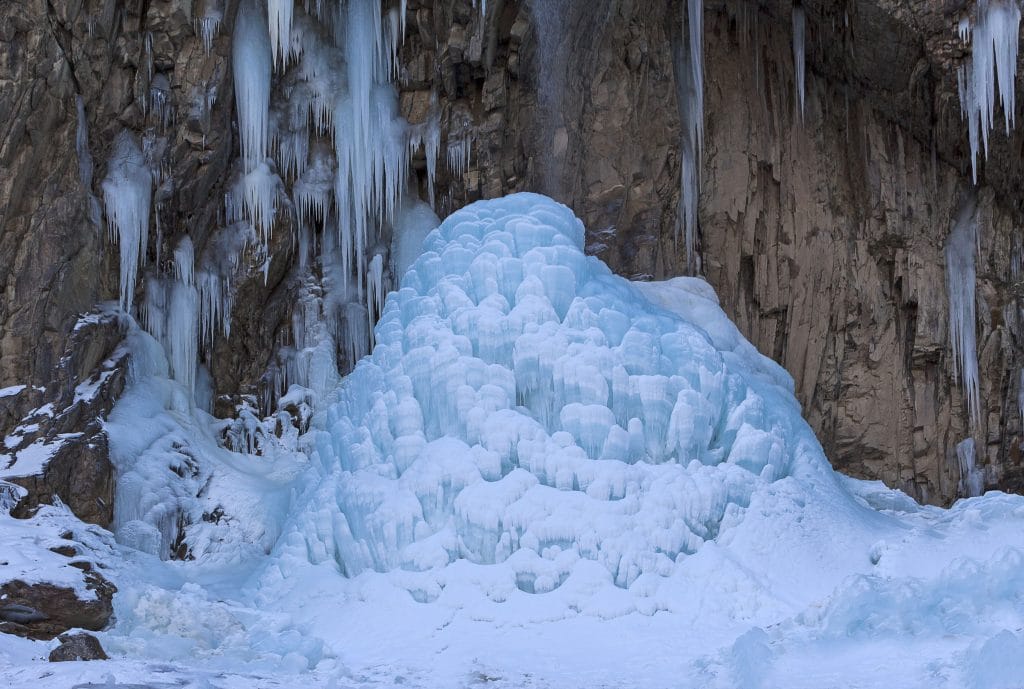
Qax is in the north of Azerbaijan, near the borders with Russia and Georgia, and has 13,000 people. It’s the town where the Caucasus Mountains begin, and the Kurhumchai River also flows nearby.
It’s a small village that you can explore on foot. It’s a great stop for travelers going to Georgia from Azerbaijan or the other way around. You can spend a couple of days here to rest, feel the pulse of what life is like in the remote mountains, hike, and visit the neighboring villages.
Getting There
There are several daily bus connections from Baku to Qax, and the trip takes about six hours. Other vans connect to Ganja and Tbilisi. There are three daily connections to the Georgian capital, and the ticket costs 8 AZN. There are two daily connections for Sheki, and the trip takes about two hours.
Alternatively, you can travel by train to Qax, but keep in mind that the station is 20 km from the village and you’ll have to find other transportation to get to the center.
What to See and Do in Qax
Icheri Bazaar
The Icheri Bazaar dates back to the early 18th century. The walls you can see nearby were rebuilt by the Russian soldiers after the Sultanate of Ilisu was annexed in 1803.
History Museum
This small museum covers the history of the region, from Ancient times to the 20th century, showcasing archaeological and ethnographical artifacts that include weapons, tools, and traditional clothes. Near the museum, there’s a Caucasian Orthodox church and an old cemetery.
St. George Orthodox Church
The church of St. George is related to the Georgian Orthodoxic, and it’s at the main street of the village, halfway between the History Museum and the Bazaar.
Ilisu
Ilisu was the capital of a sultanate annexed by the Russians at the beginning of the 19th century. In 1844, there was a failed attempt to oust the Slavic, that ended in battle near the village. After that, the village was destroyed by the Russians who stayed in the area until the fall of the Soviet Union and the independence of Azerbaijan.
Vans frequently depart from Qax to Ilisu, every hour or so. You’ll cross over the 16th-century bridge on the way to the village. One of Ilisu’s other attractions is the waterfall on the outskirts of the village, about 30-minute walking distance from the nearby parking lot.
Saribash
Saribash is another mountain village. Peaceful, with welcoming people, and surrounded by peaks almost always covered in snow. It’s a good place to visit if you’re staying in Qax. The road to Saribash that you can only travel by jeep is particularly scenic and adventurous.
Qum
In this village, a couple of kilometers from Qax, there are several ruins of Albanian 16th-century churches, including the Church of the Mother of God. It’s 36 meters in length and 19 meters in width, and you can still see the remains of three aisles supported by arches.
Quba (1 day + 1 for the mountain villages)
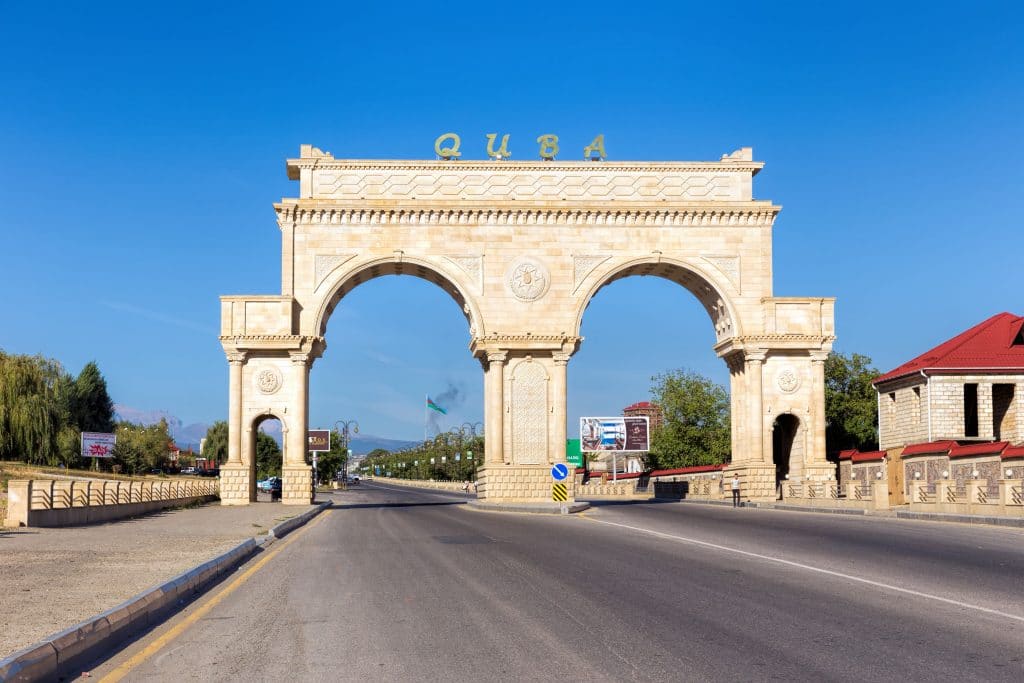
You can travel the 160 km between Baku and Quba (sometimes spelled as Guba) aboard a van that will cost you 4 AZN. The trip takes about three hours, and I recommend you leave as early as possible because there’s a lot to see in the city. These vans depart from the bus station at the beginning of Heydar Aliyev Avenue. Shared taxis to Quba leave from the Shamahinka and 20th January stations.
Quba is a mountain town, famous for its apples and tapestries, and you shouldn’t add it to your Azerbaijan itinerary if you’re traveling in the winter. In the summer, though, it’s quite a popular destination, a common refuge from the hotter days in Baku.
The capital of Fatali Khan was established in the 18th century in the oldest part of the city by the Qudiyalçay River. However, when this political union became part of Russia, the importance of Quba faded.
On the north, across the river, lives a fascinating Jewish community, Qırmızi Qəsəbə, allegedly prosperous and certainly very active, with two beautiful synagogues.
The modern Quba stretches along 3 km to the east, with Flag Square as its central point.
Things to See and Do in Quba
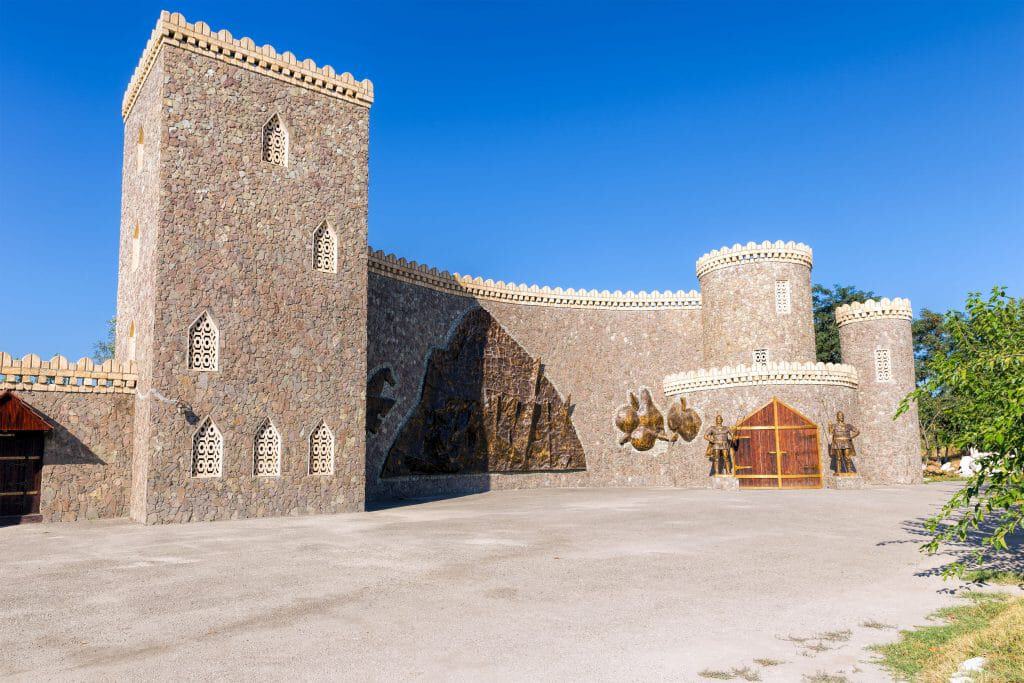
Cümə Məscid
This late 18th-century octagonal mosque made of brick is probably the most iconic building in Quba. The oversized metallic dome is laid over the mosque that has a thin minaret built in yellow stone.
1918 Genocide Memorial
This complex inaugurated in 2013 is dedicated to the victims of the 1918 massacres by groups of Armenian Bolshevik. At the time, over 160 villages were destroyed, and it’s estimated that almost 17,000 people were slaughtered.
The memorial was built at the place where a mass grave was found in 2007. The bones found there are part of the memorial, where you can also visit an underground museum and a couple of pyramids.
Günbəzli Baths
These baths, also known as a hammam, were built in red brick in the 18th century and are shaped in the typical hexagonal format of this sort of facility.
They’re not well preserved, but they’re well framed by the neighboring buildings that are the evidence of Quba’s golden age.
Museum of Regional History
This museum is inside a building that resembles a castle, near Meydan Square. The exhibition focuses on the History of the region of Quba, with jewelry from the Bronze Age, gorgeous Azerbaijani carpets, ceramics, and old weapons.
Day trip from Quba: the village mountains
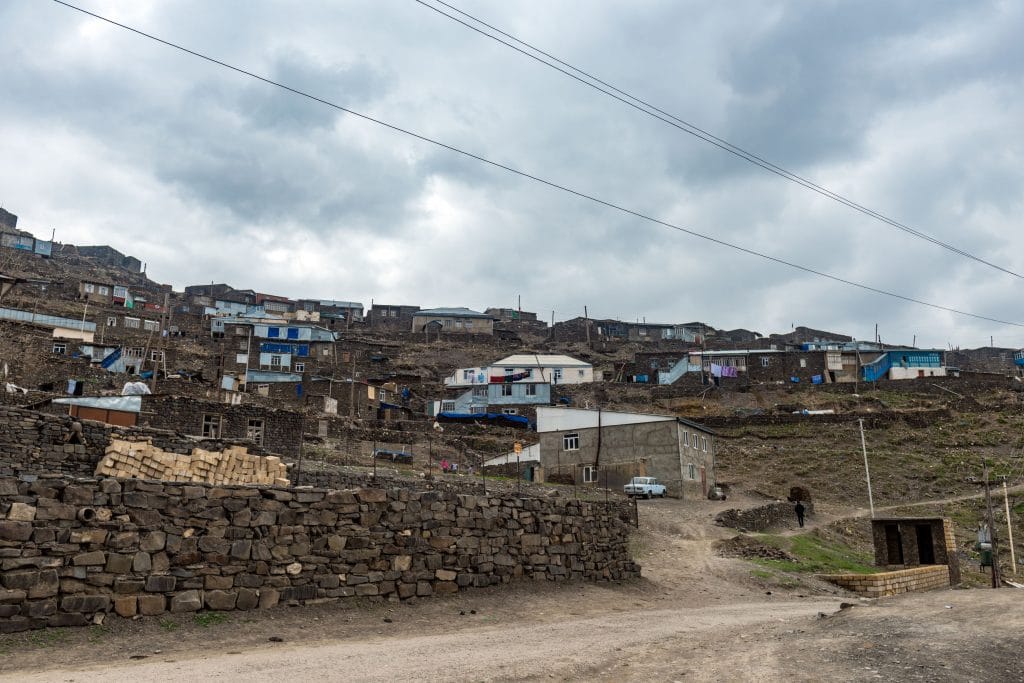
Quba is a great base to visit the mountain regions, particularly the villages of Buduq, Xinaliq, and Laza.
Buduq is 90 km from Quba, and it’s usually inaccessible in the winter. Here they speak a local dialect, as well as in the neighboring villages of Pirüstü and Qab Qazm.
Laza is in a mesmerizing valley, with breathtaking views and surrounded by crystal-clear waterfalls. Here people are welcoming, and you’ll be able to see the region’s typical houses. You can’t skip visiting the mosque in the center of the village.
Xinaliq is one of the highest villages in Europe, and it’s now easier to reach thanks to a newly paved road. Eight-hundred people live here, most all of them in typical stone houses with spacious terraces. The local language is Ketsh, and it’s not spoken anywhere else in the world. The village has a small museum dedicated to local culture.
Quba – Baku – Sheki (1 Day)
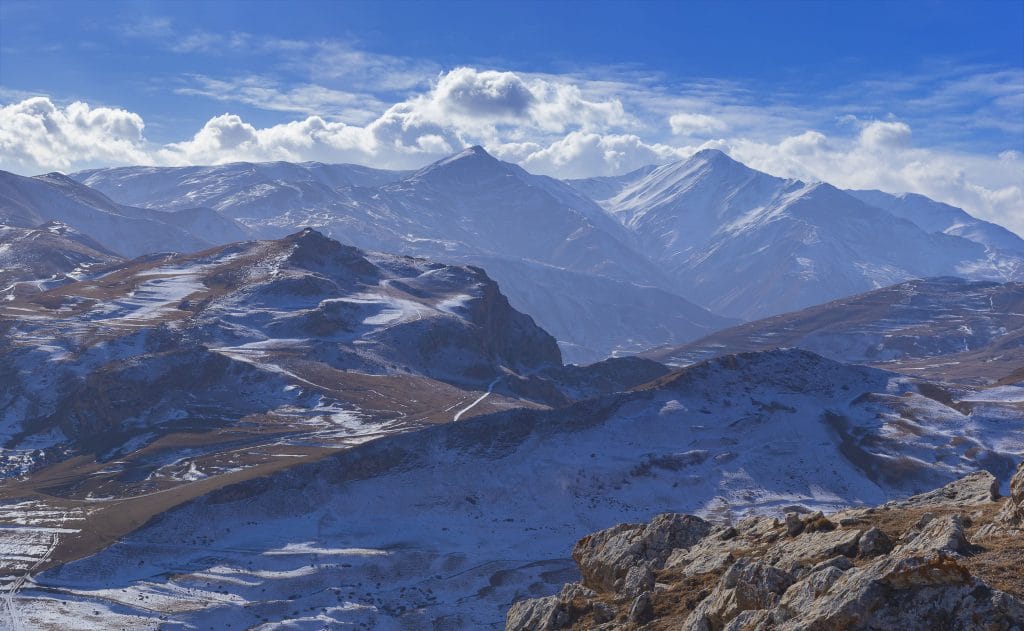
Looking at a map, it seems like it would be easier to travel to Sheki from Quba, but in reality, the mountains get in the way of a route that could definitely be shorter.
You have to go back to Baku and from there travel to Sheki. By road, it’s about 300 km, and you can travel there by taxi, van, or bus. A shared cab costs 15 AZN per person and a seat in a van, for a 6-hour trip, costs 6 AZN.
Alternatively, you can spend the rest of the day in Baku and take the night train to Sheki, that departs at 11:20 pm and arrives at 7:10 am the next day. You can use the extra time in Baku to revisit some of the places you enjoyed the most or going to a must-see you didn’t have time to visit before. Train tickets can be purchased online. There are three classes with different prices, from 6 AZN to 19 AZN. All of them have a bed where you can spend the night but, of course, the quality also varies depending on the class.
Please note that the Sheki train station is 17 km from the city center and you’ll have to either take a taxi (that can cost between 5 and 10 AZN depending on your negotiating skills) or walk to the main road (about 200 m from the center) to try to get a seat at a van going into the city.
Sheki (1 Day + 1 for a day outdoors)
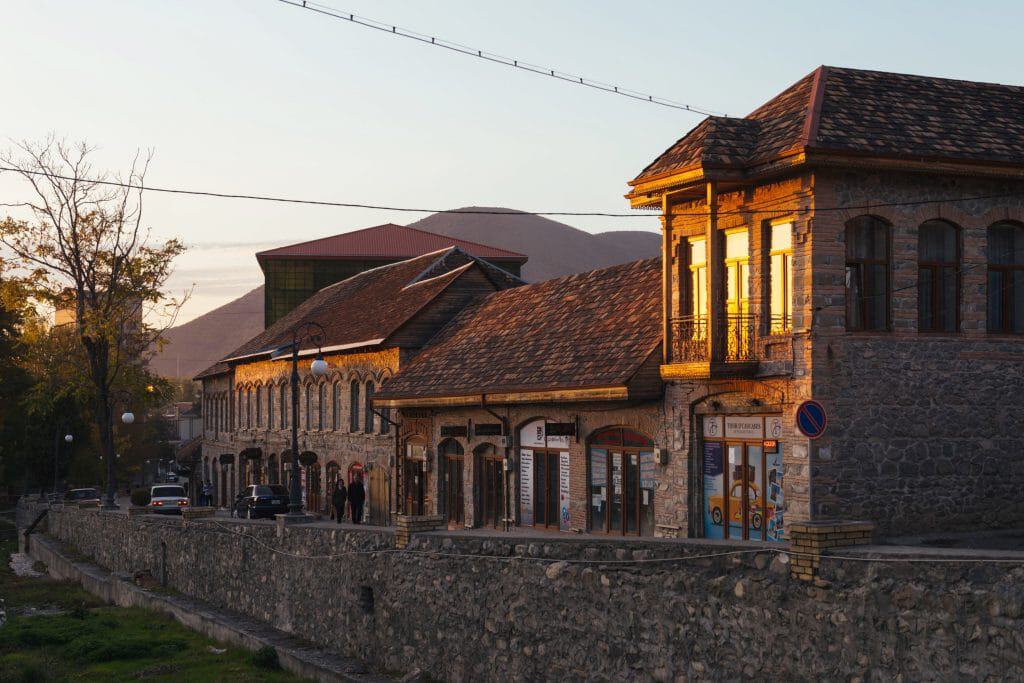
Besides Baku, if you had to choose just one more place to visit in Azerbaijan, that place had to be Sheki.
It’s a mountain city with an incredibly rich past. It was an Albanian state, it was part of the Silk Road, it was continuously occupied by Persians, Romans, Parthians, Arabs, and Mongolians, always swaying between times of sovereignty and times of inclusion in powerful political unions. After the collapse of the Safavid Empire in the 18th century, Sheki was once more independent as a Khanate. The older buildings in the city are from that time because the continuous devastation and invasions stopped any heritage older than that from making it present time.
At the beginning of the 19th century, Russia annexed Sheki. From that time until the independence of Azerbaijan, Sheki was under Slavic control.
It’s a compact city, and you can easily walk between the main points of interest. However, if you like to explore a place on a deeper level, local taxis are cheap, and there are several mini-bus lines serving all streets of Sheki.
What to See and Do in Sheki
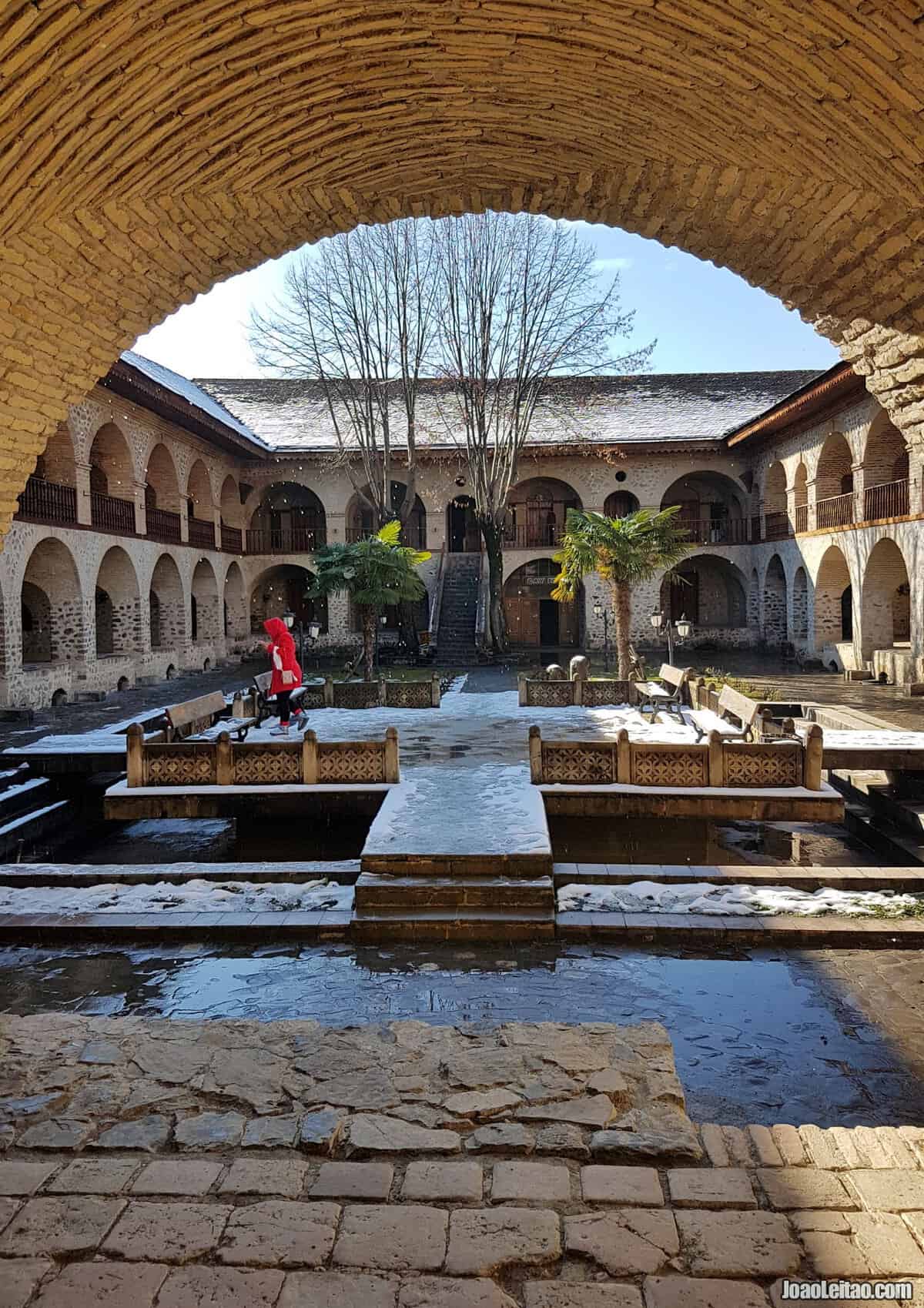
Juma Mosque
This is the main mosque in Sheki, built in the mid-18th century, decorated with geometrical patterns and with a minaret 40 meters high. It’s open for visits from 6:00 am to 9:00 pm and a donation is expected at the end.
Khansarai Palace (Palace of the Sheki Khans)
This palace, built in 1762 by Khan Hussein as the administration and government center for the Khan of Sheki, is a must-visit for anyone traveling in the city.
From the courtyard, you have a great view of Sheki, and you can admire the details of the palace’s architecture.
Its interior is not very large, but it’s exquisitely decorated, mostly with floral patterns. At the top hall, you can see an elaborate scene depicting the battle of Haci Çələbi against the Persians in 1743.
All tours are guided and last for about 15 minutes. Please note that you can’t photograph inside the palace.
Caravansarai
This is the most evident mark of a time when the traders who traveled the Silk Road came to Sheki with their merchandise. The Khans built an inn in Sheki to offer them shelter and a reason to travel there. At the 18th and 19th centuries, it was one of the five accommodations of what is now known as Azerbaijan and the biggest caravanserai in the Caucasus.
It’s still used as an inn and serves meals, although not for caravans and merchants anymore.
Winter Palace
It’s the second Khan palace in Sheki, recently restored and opened to the public. The interior is somewhat disappointing, with a lot of empty rooms, but at least in one of them, you can see frescoes depicting the poems of renowned Nizami, a 13th-century author. You can take photos inside and there’s an English-speaking guide who lives next door.
World War II Memorial
If you haven’t visited many soviet memorials to the Second World War yet, you might enjoy coming here to see the grand style, the clear socialist design, the finest example of an era that ended with the collapse of Soviet Union. Besides the interest in the memorial itself, you can come here for great views of the city.
Yuxari Baş
The countryside-like atmosphere in this neighborhood of Sheki is so strong you might think you’re at a remote village. In addition to paying attention to this particular environment, take a closer look at the 1880 mosque and its octagonal-shaped minaret.
Fazil Labyrinth
This is an archaeological site where they found graves dating from the 2nd century to the 7th century. It’s managed by the two archaeologists who dedicated their work and lives to this site. To visit, you have to book with them in advance at the Sheki tourism office. It’s about 25 km southeast of the city and if you don’t have a car, say so when booking the tour and they’ll handle it for you.
Day Trip from Sheki: Hiking Trails
You don’t have to go too far to hike. You can start your hiking trip right behind the Khansarai Palace. The vast network of hiking trails is kept by lumbermen and shepherds. The trail goes uphill, and you can hike all the way to the top, 2,050 meters high.
But there are other options. Take a bus from Sheki to Bash Kyungyut (buses leave at 9:00 am and 3:00 pm, but double check the schedule), visit the Albanian church at the village, and then find a car that will take you to Bideiz. Walk the 5 km that separate the two Albanian ruins. It’s a short hike but worth it. After that, you can return to Sheki.
Carry your passport when hiking. It’s possible the authorities will ask you for identification.
Ganja (2 Days + 1 to visit Lake Goygol)
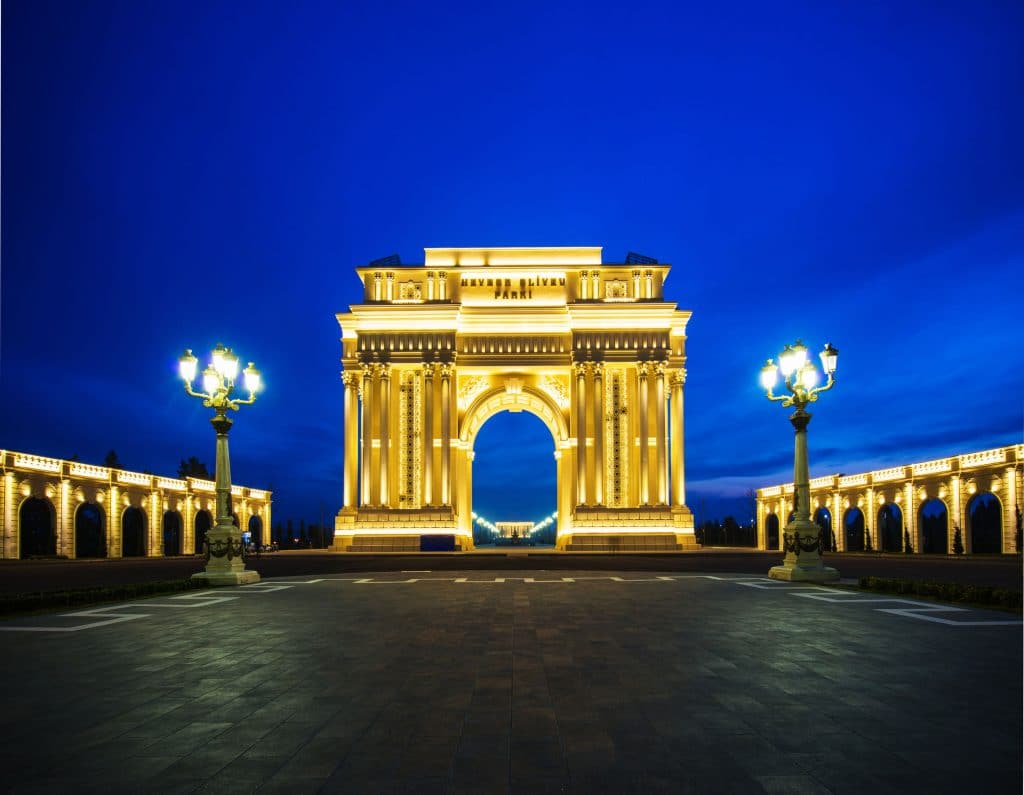
It’s the second largest city in Azerbaijan, 370 km east of Baku, but you don’t have to return to the capital to travel there.
Typically, there are buses from Sheki to Ganja that depart at 8:00 am, 8:30 am, and 1:30 pm. However, it’s best to double check the schedules when you’re in town. Be aware that if the bus is full, it might leave ahead of schedule, so it’s best to be there as early as possible. The ticket costs 4 AZN, and the trip takes about two and a half hours.
Things to See and Do in Ganja
Heydar Aliyev Square
The central square of Ganja is the perfect example of Socialist architecture, where the building of the City Hall stands out. The façade, with massive arches, is a good example of Socialist Classicism. Although the communist symbols were replaced by Azerbaijani ones, if you take a closer look, you can still some marks from the Soviet era.
The statue of Lenin that used to be here during the USSR was replaced by a bronze statue of legendary president Heydar Aliyev. It’s a great starting point for a self-guided walking tour of the city’s most significant places.
Shah Abbas Mosque
This is the main mosque in the city, also known as Friday Mosque or Juma Mosque.
It was built in 1606, and the minarets were added in 1776. It underwent renovation works in 1910 and 2008. The mosque has red brick walls, lots of stained-glass windows, and a massive dome, and if you have the chance take a look inside.
Chokak Baths
These baths near the Shah Abbas mosque were turned into a handicrafts store due to the damages to the plumbing system during the Soviet era. The architecture of the complex is quite interesting and worthy of photographing.
Mausoleum of Javad Khan
Here lie the remains of Javad Khan, one of the last Kings of the Khanate of Ganja who ruled from 1786 to 1804. He died in the battlefield while fighting the Russians, so he’s considered a national hero.
His grave had been lost but was found by accident during construction work in the Soviet era. The current mausoleum was built in 2005.
Ganja State Philharmonic Hall
Although the grand building of the Philharmonic Hall looks hundreds of years old, it was inaugurated in 2017 by the President of the Republic. The concert hall has the capacity for 1,200 people, and there’s a conference center with 300 seats. Two fountains were built in front of the main façade, which has five statues of the great figures of the Azerbaijani culture: Uzeyir Hajibeyli, Fikrat Amirov, Gara Garayev, Niyazi, and Arif Malikov.
Shah Abbas Caravansarai
This former inn for merchants is one of the oldest buildings in the city, built in the 17th century and recently renovated. It’s very central and easy to get to.
Alexander Nevsky Church
This church built in 1887 is a testimony of the years of Russian occupation. After the Revolution of 1917, the church was closed as a temple but used for a series of secular duties until the end of the Second World War. In 1946 it was allowed to be used as an Orthodox church.
Bottle House
This is a very peculiar house. The façade was decorated with 50,000 bottles by artist Ibrahim Jaffarov, and you can also see the photo of his brother Yusuf who never returned home after the Second World War. His disappearance, however, is shrouded in mystery because surprisingly he wrote back to his family in 1957, 12 years after the end of the war. No one heard from him again ever since. The house has an inscription that says Zhdem, which means “we’re waiting for you.”
Mausoleum of Nizami
Nizami Ganjavi is the greatest poet in Azerbaijani history, and you can visit his mausoleum in Ganja. It’s a more modern structure made of granite in 1991 to replace a former version built by the Soviets in 1947. The mausoleum of Nizami has, in fact, been many times complemented, redesigned, destroyed, and rebuilt since the 14th century.
In a country where poetry is taken seriously, the place is naturally a popular one. Lovely gardens encircle the mausoleum, and the Museum of Nizami that opened in 2014 is across the street. The complex is in the outskirts of the city, so it’s best to take a taxi to go there.
Mausoleum of Imamzadeh
This mausoleum is particularly charming and must-visit thanks to its gorgeous architecture. The complex has several mosques, a cemetery, and a caravanserai.
The original mausoleum dates from the 6th century but multiple reconstructions have completely changed its design. The last works happened in the 19th century, and the structures have a somewhat crumbling look that only brings out the charm.
Heydar Aliyev Park
It’s the largest park in the Caucasus. It’s, in fact, massive in size and has a replica of the Paris’ Arc de Triomphe and the arches of ancient Rome. It’s the perfect place for people watching, especially on weekends. I recommend to also visit at night when the monuments light up and become even more spectacular.
Day Trip from Ganja: Lake Goygol
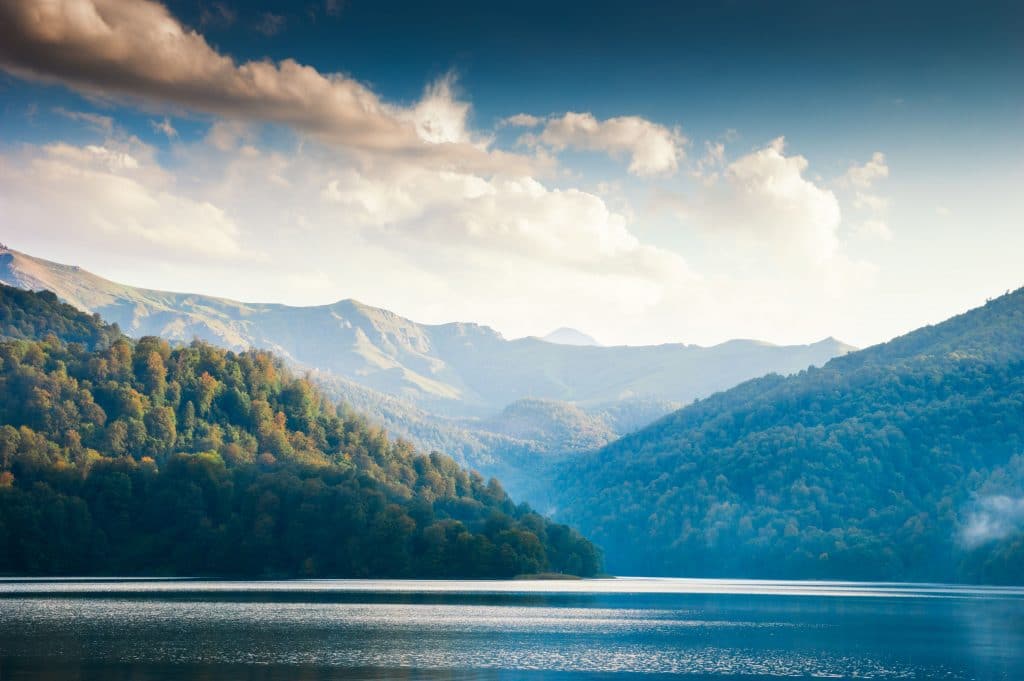
Lake Goygol is the most famous one of the eight massive lakes in the Ganja region, and its name translates into “Blue Lake.”
It’s at the foot of Mount Murovag and surrounded by mountains. Its beauty is legendary. The lake was formed after an earthquake in 1139 that blocked the natural course of Kürəkçay River.
Fun fact: the closest town to the lake, Khanlar, was initially called Helenendorf and founded in 1819 by German settlers. The remaining German community disappeared during the Second World War.
The easiest way to reach the lake is by taxi. Expect to pay about 20 Euros to visit the lake, but if you have the budget or are traveling in a group, it’s more advantageous to hire the taxi for the whole day for 80 AZN (41 Euros).
End of the travel in Azerbaijan
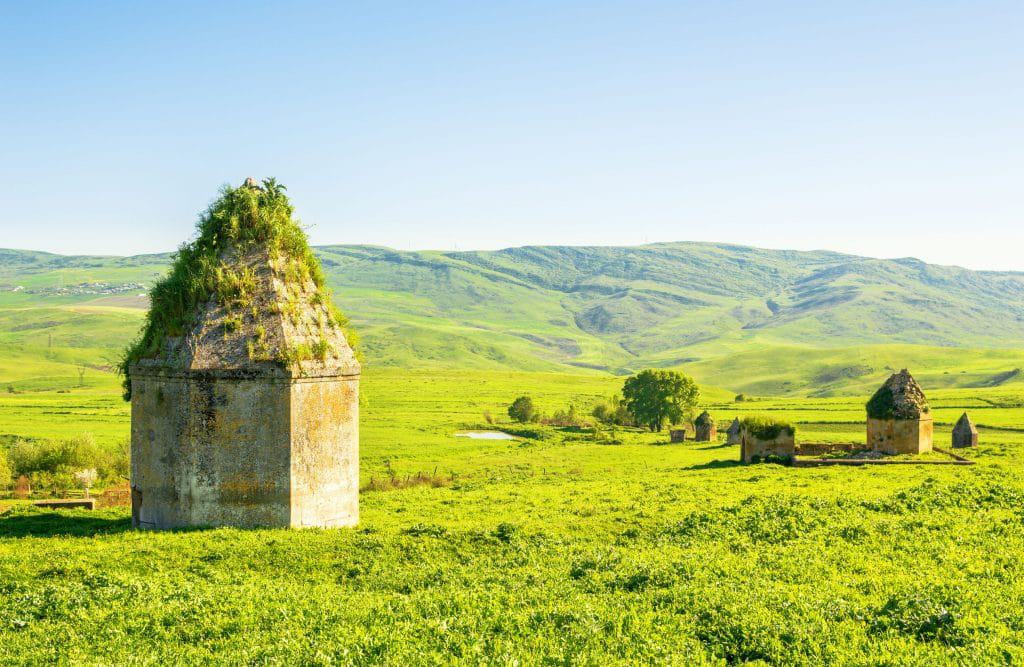
From Ganja, you can return to Baku and catch the flight to your next destination. However, if you’re traveling to Georgia next, you can travel directly to Tbilisi from Ganja.
What I Didn’t Include
Fifteen days are never enough to get to know the country. Here’s a list of other places you can visit if you want to plan a different journey. These weren’t included in this itinerary simply because it’s not possible to see them all in a short time.
Gabala
Gabala is 240 km northeast of Baku, not too far from Mingechevir.
This ancient city was founded over 2,000 years ago, and it’s the oldest city in Azerbaijan. For 600 years it was the capital of Caucasian Albania.
Despite constant invasions and destruction, you can still see the traces of that glorious past in Gabala.
Modern Gabala is about 15 km from the ancient ruins, and you might want to consider spending the night here, if you have the time, before heading to Sheki.
Lankaran
Lankaran is in the southeast of Azerbaijan, near the border with Iran. If you’re traveling to or arriving from Iran, you will most likely stop at this city. It’s a subtropical paradise with a relaxed resort-like environment.
Lankaran is a combination of rich History with gorgeous beaches. Must-sees include the 18th-century castle in the historic center, the mosque at the Kichik Bazaar, and the mansion of Mirakhmad khan built in 1913.
If you can, visit Khanege about 100 km from Lankaran where you’ll see one of the most beautiful medieval castles, the tomb of Pir Hussein, a mosque, and other historical buildings.
Mingechevir
On the shore of a vast reservoir, Mingechevir has a wonderful freshwater beach, but the archaeological complex is its main attraction. The oldest traces found there date back to 2,000 BC, but you’ll also see recent structures, up until the 17th century, like necropolises and Christian temples.
Archaeologically speaking, the whole area is extremely rich with different identified periods in both shores of Kur River.
Nabran
Nabran is on the shore of the Caspian Sea, 200 km north of Baku, and was founded by Russian settlers in 1900. These days it’s a beach town, surrounded by beautiful forests, and a haven to get away during the hot summer months.
Nakhichevan
Located near the border with Iran, it’s the oldest city of Azerbaijan, founded in the 7th century BC during the Caucasian Albania period. It was the capital of the Seljuk State in the 11th century, and in the following centuries, it was the center of the Ildigizid State. It was annexed in 1828 by Azerbaijan and became part of the Soviet Union.
You can visit several medieval monuments in Nakhichevan such as the 12th-century Mausoleum of Yusuf Bin Kuseyir.
Shamakhi
Shamakhi is 120 km west of Baku, en route to Sheki. It has a long history that starts at the beginning of the 5th century BC. It was the capital of the Shirvan Empire from the 4th century to the 16th century, and by the mid-18th century, it was the center of the Shamakhi Khanate.
Nowadays, it’s known for its wines and carpets, but you’ll still be able to spot those signs from the past: the 11th-century fortress of Gulistan, the mausoleum of Addy-Gyumbez, the Juma Mosque, and several structures in ruins from the 10th to the 17th centuries.

